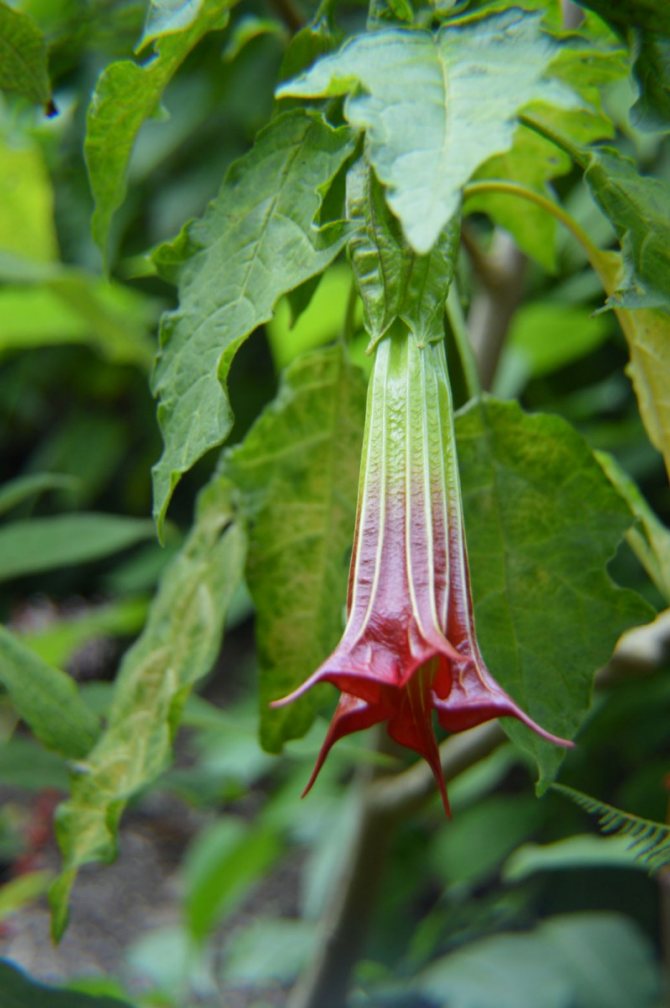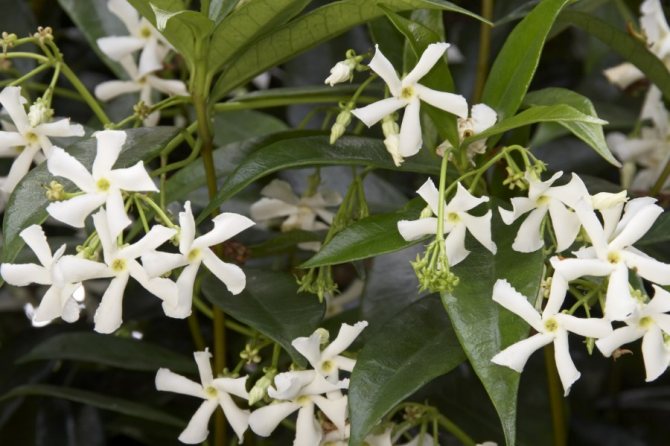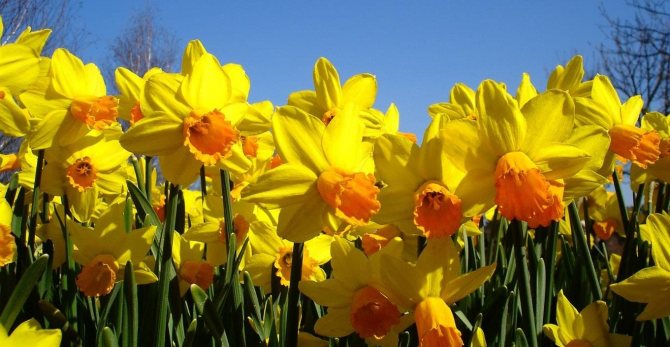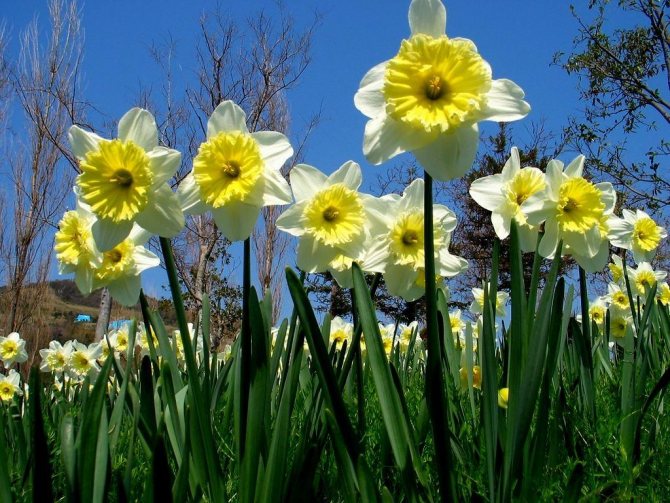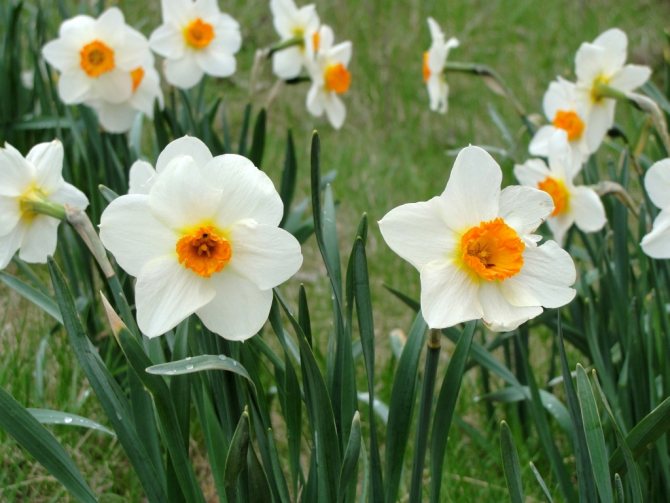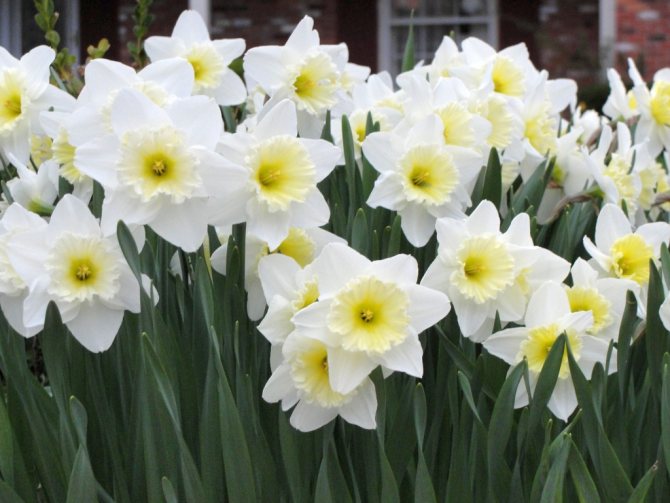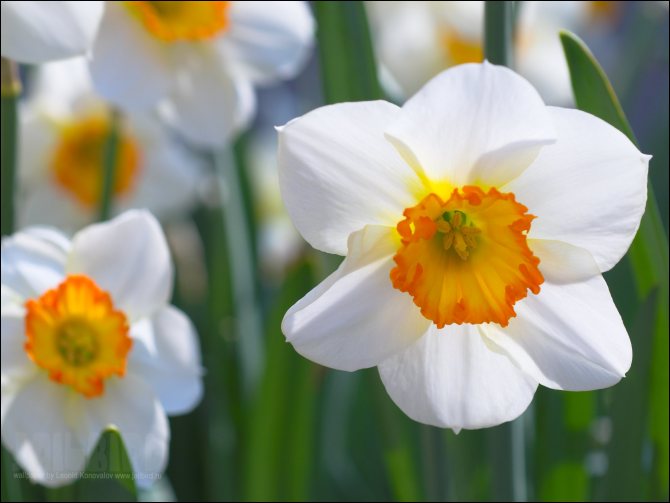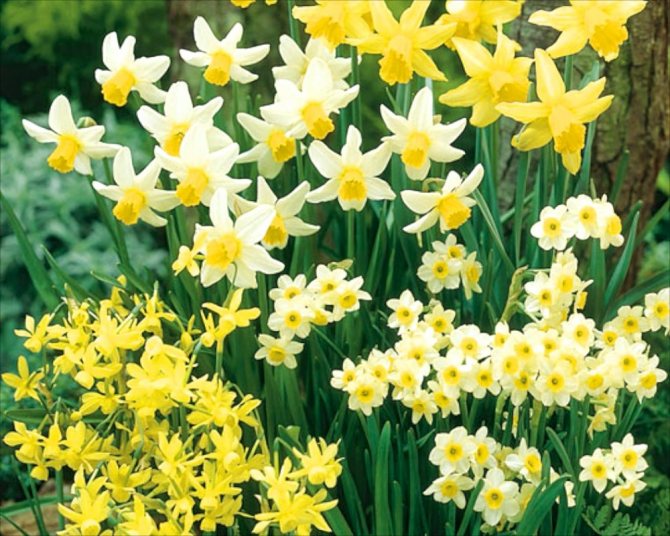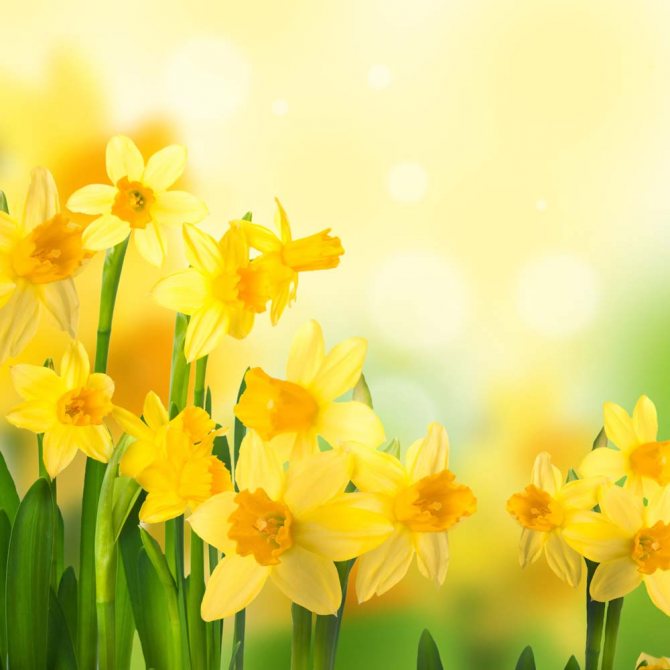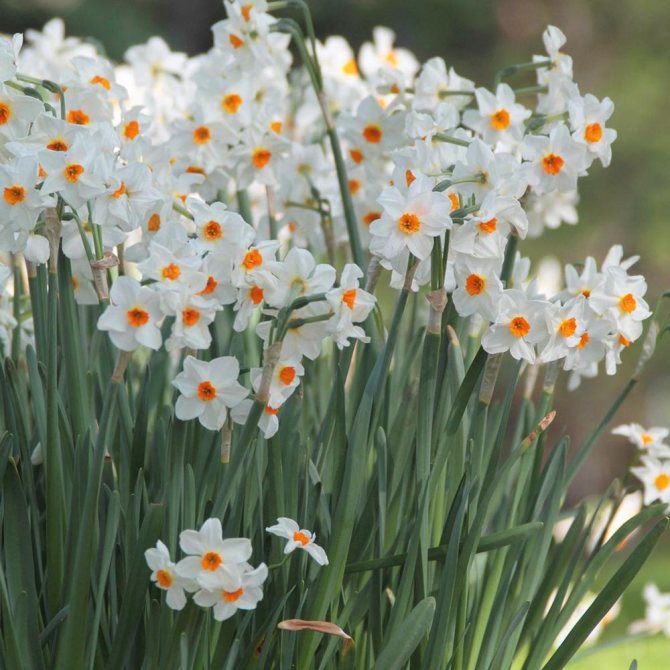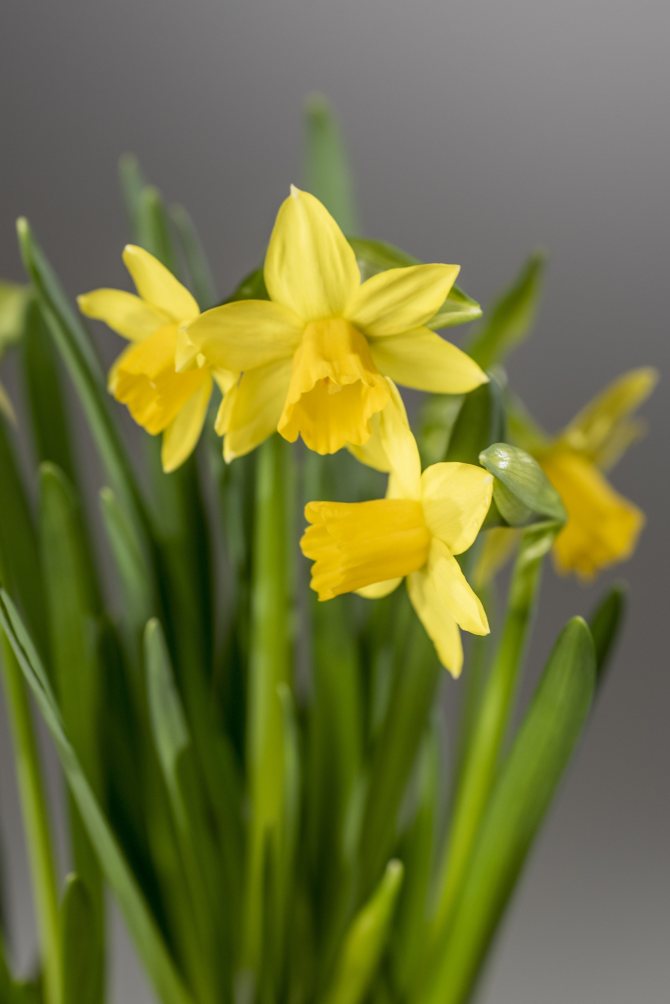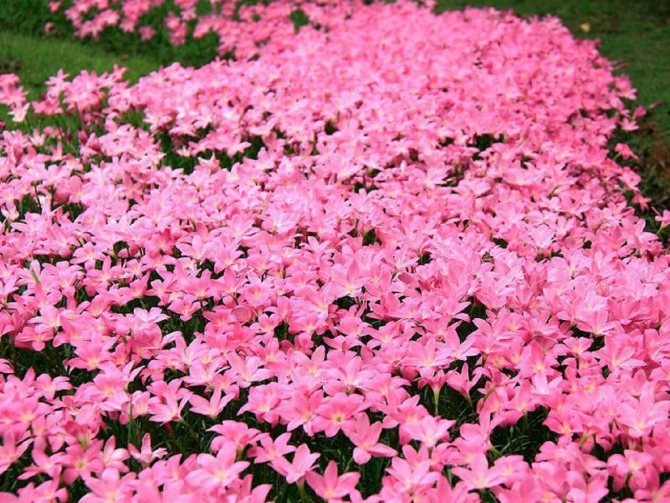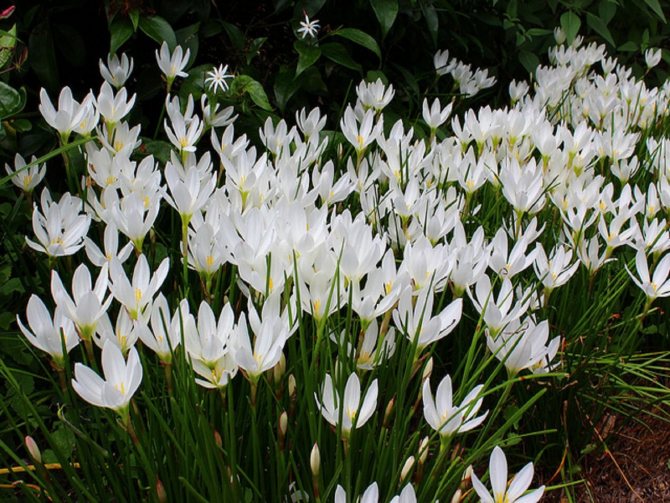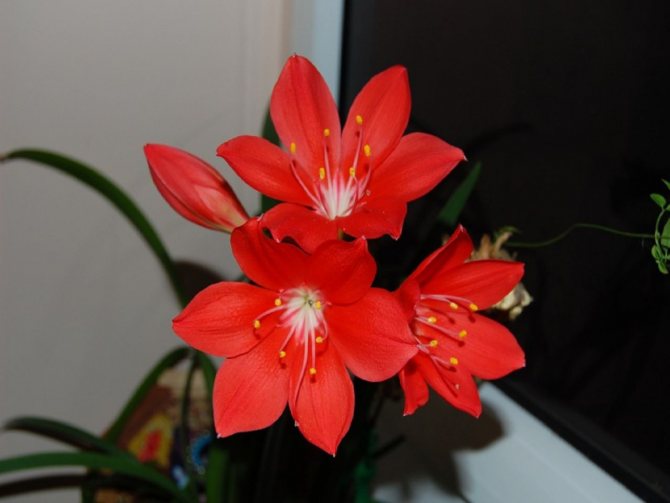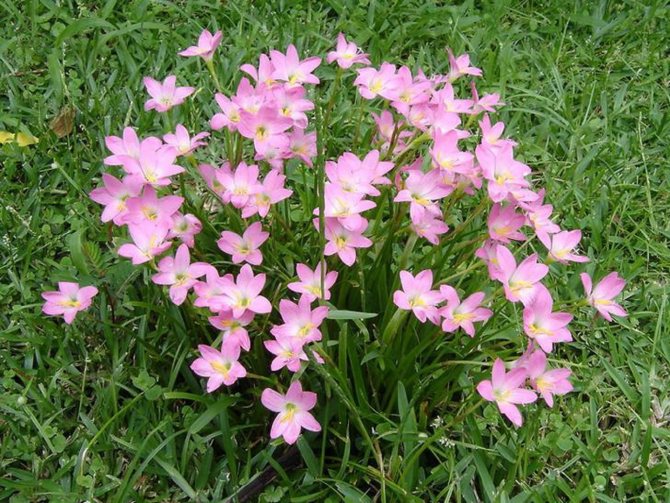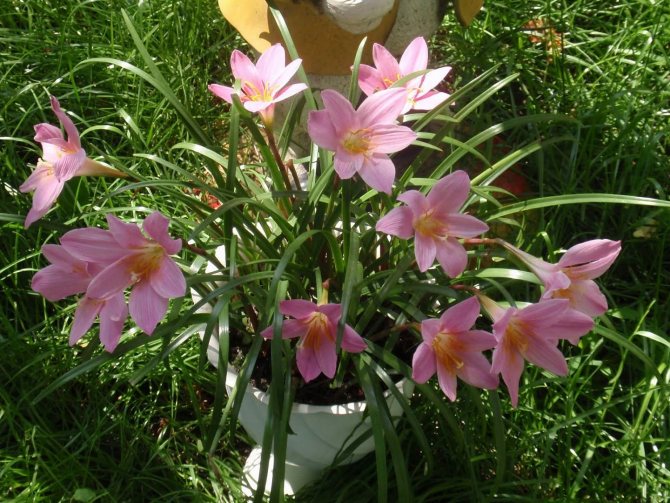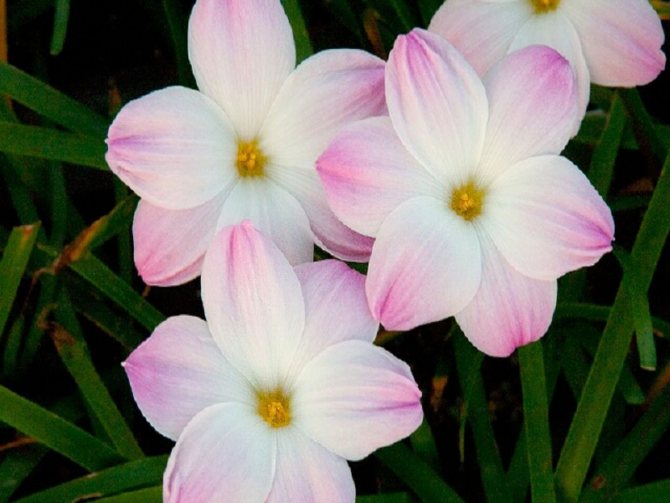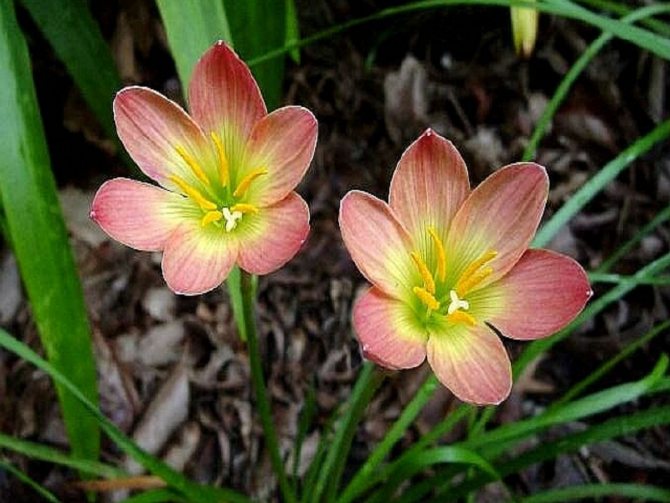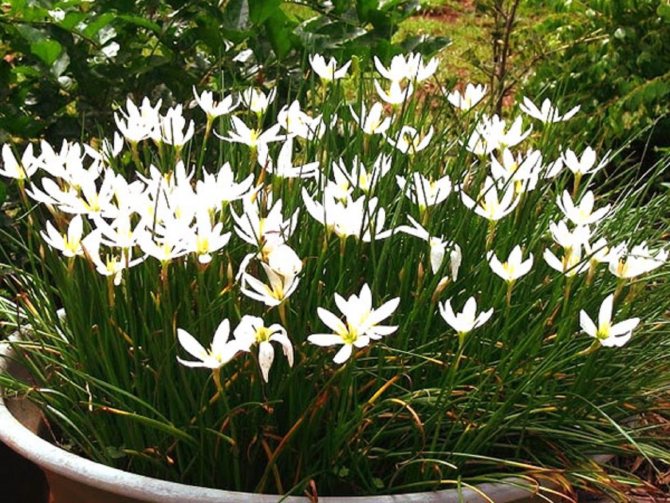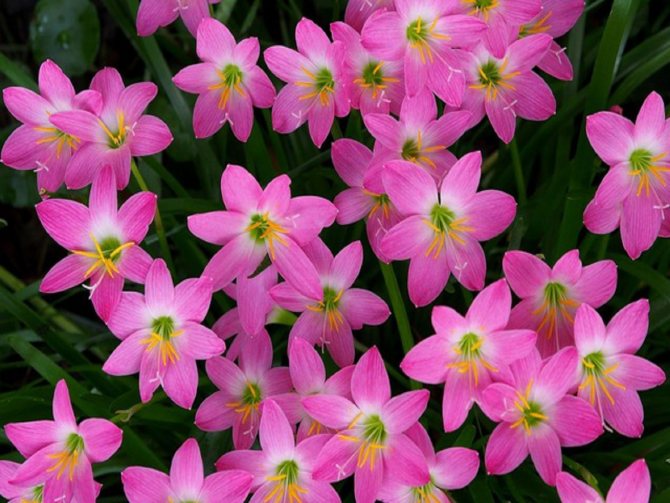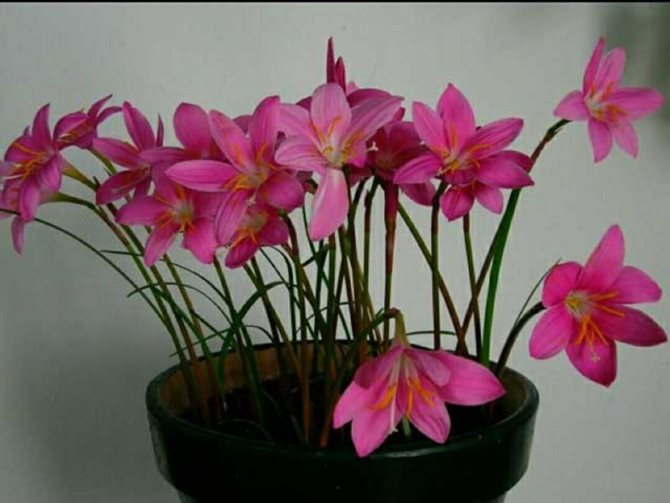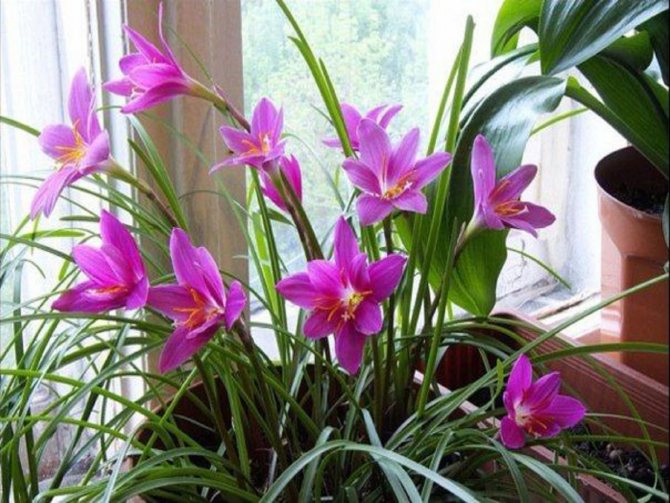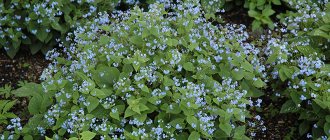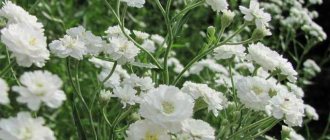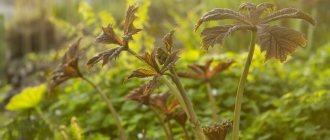Daffodils are decorative perennial plants. They belong to perennial bulbous plants of the amaryllis family. The flowers are usually yellow or white, single or several at the top of the peduncle. Many people love these flowers and plant them to improve the landscape design of their summer cottage.
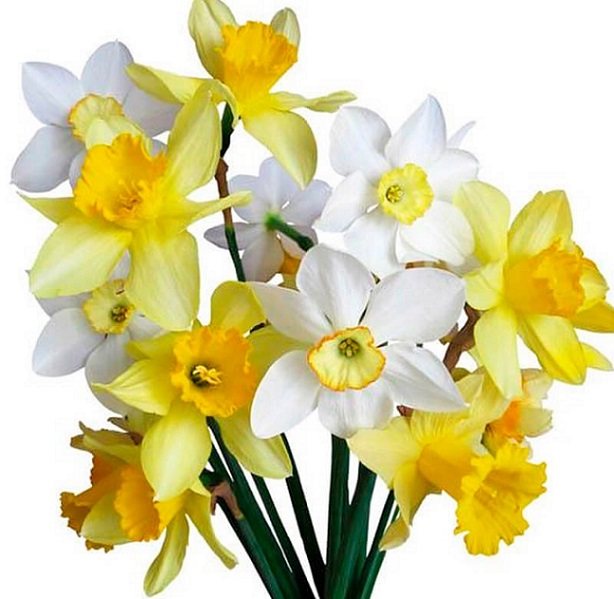
The purity of "friendly eyes" looks at us in the spring garden. A garden without daffodils, their charm, delicate, exquisite beauty and delicate aroma of flowers loses a lot. Plant just a few bulbs of this unpretentious plant in any corner of your property and you will see their beautiful bowed heads.
There are about 60 known species of daffodil that are common in the Mediterranean. Narcissus loves alpine meadows, mountain slopes, lowlands, mountain valleys.
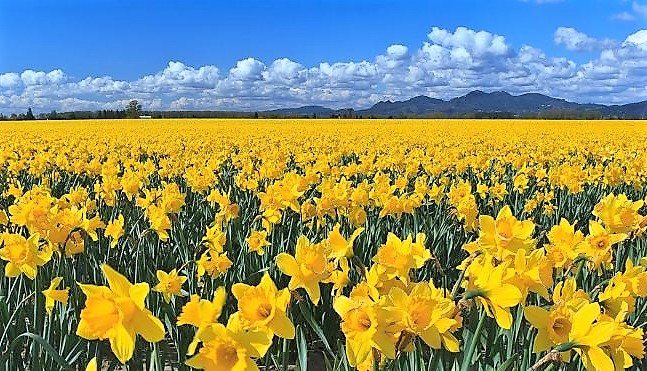

Narcissus description
Indoor daffodil is a herbaceous bulbous plant. During the period of the most active growth, long foliage is formed, resembling a ribbon in its appearance.


Blooming yellow daffodil
Flowers, as a rule, are solitary, but there are varieties with flowers collected in loose type inflorescences. Inflorescences are always located at the highest point of the bush.
They are located on a separate stem, so the bulb does not suffer at all during pruning.
The perianth is white or yellow in color, and usually consists of six oval petals.
The center of the inflorescence is a crown, which also has a white or yellow color. The crown is also surrounded by six stamens.
The bulb always has two constantly renewing buds, which have a distinctive developmental stage. They are covered with dense brown skin and resemble a pear in their shape. The most intensive development of the root system was observed in the autumn period.
Narcissus is a bulbous plant that blooms with white or yellow uncomplicated flowers.
Variety of varieties
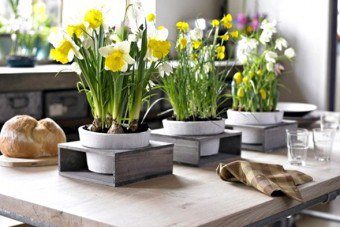

Daffodils are one of the first to bloom after a long winter, bringing bright colors and spring mood to a boring gray-white-black life.
Depending on the plant variety, of which there are currently more than thirty, the leaves can have different lengths and widths, but the color of the leaves is always the same - rich dark green.
The flowers are simple and double white and yellow. There are also varieties with a two-tone color of the crown. More recently, a very beautiful flower variety with a pink crown has appeared. The flowers are located on separate peduncles, so pruning them does not cause any harm to the bulbs.
A feature of the bulbs of this plant is the presence of two renewing buds at different stages of development. The bulbs are covered with a dense brown skin, have an elongated shape resembling a pear. Roots grow most intensively in the fall, they live for 10-11 months, after which they die off.
There are many varieties of indoor daffodil (Magnet, Fortune and Yellow sun), but the most popular variety is Paper. It has many snow-white flowers, located at the same time on one peduncle.
With proper care, domestic daffodils bloom from December to March inclusive.
Popular varieties
Daffodil varieties can differ in the following features:
- Foliage can be of distinctive length and width;
- Flowers have a double and regular texture.
But it is important to note that, despite some distinctiveness in the foliage, their color always remains saturated green.
Recently, a new crop variety has appeared, which differs from the usual daffodil by the presence of a beautiful pink crown.
The most common varieties of indoor daffodil are:
The "Paper" variety is most actively used, and this is not surprising, since it differs in the placement of a large number of snow-white flowers at the same time on one peduncle.
There are about 30 types of different varieties of daffodil, but the most common variety is "Paper".
Daffodils - photo: Daffodils with the name of the variety and photo
Modern varieties pleasantly surprise with rather unusual shapes and a wide range of colors - from snow white to creamy white, creamy and greenish white and from lemon yellow to bright saffron yellow, dark orange. Among the latest breeding novelties, there are even outlandish pink and white flamingos.
Variety - Orange (Orangery)


Variety - Palmares
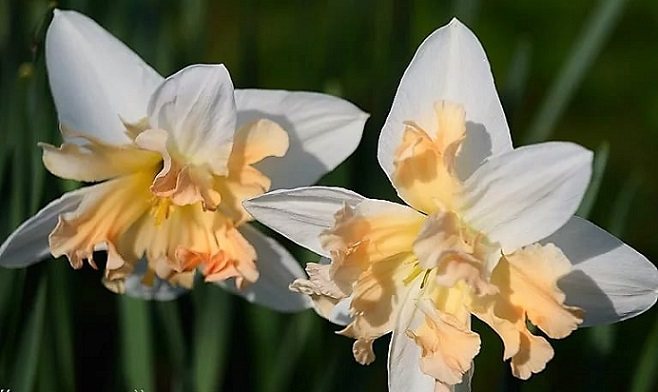

Variety - Intriga (Intrique)
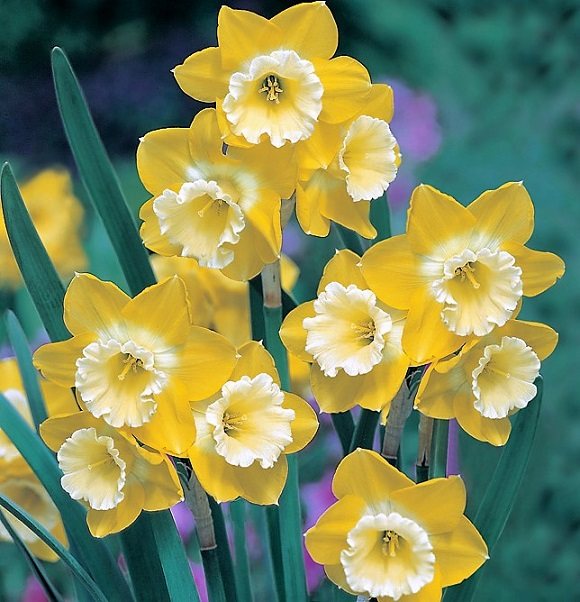

Variety - Flowerbed (Floverdrift)
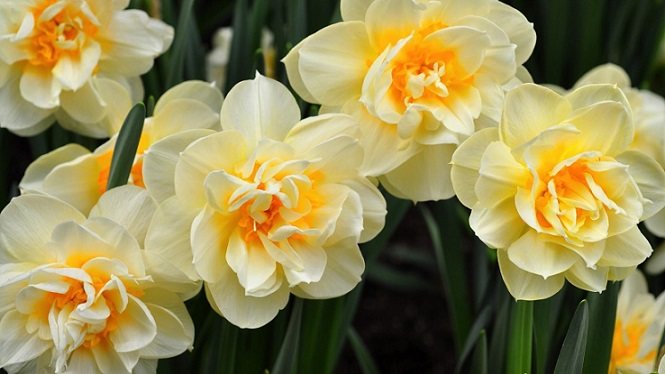

Variety - Dear Love
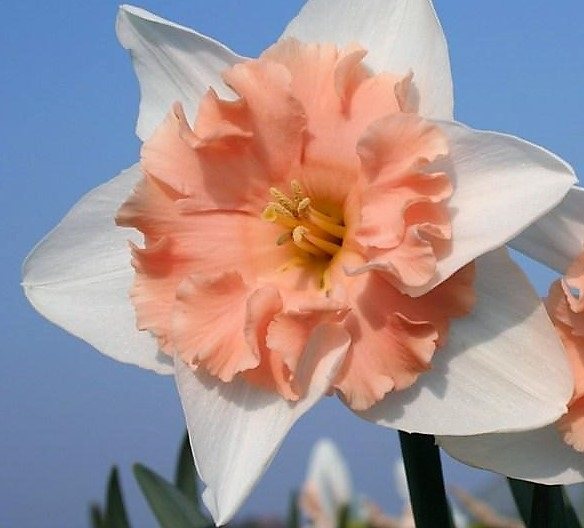

Variety - Good Mood (Narcissus Erlicheer)
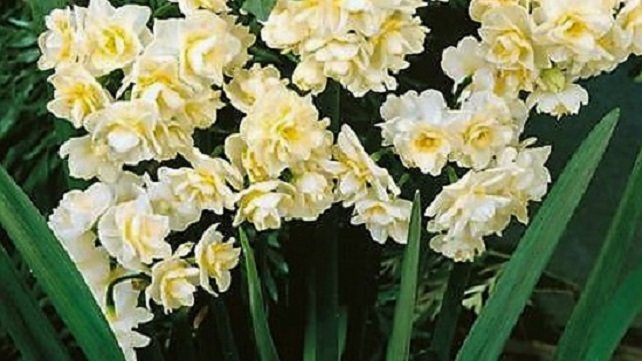

Variety - Rainbow of Colors
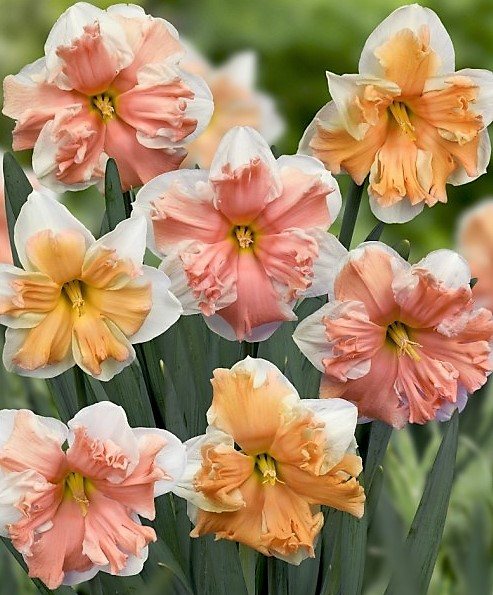

Variety - Gloriosus
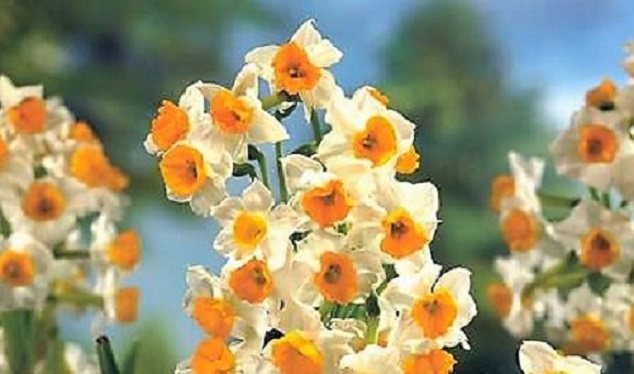

Variety - Floralie
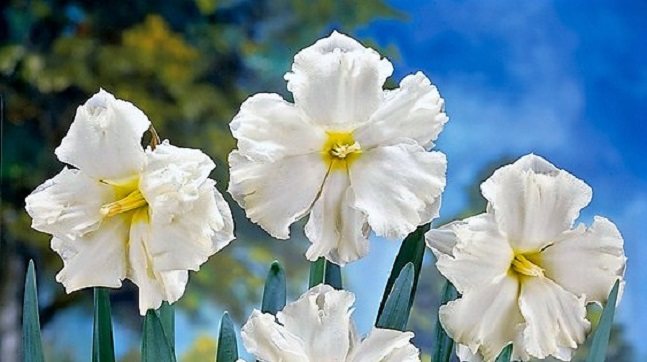

Narcissus floralie
Variety - Chanterelle
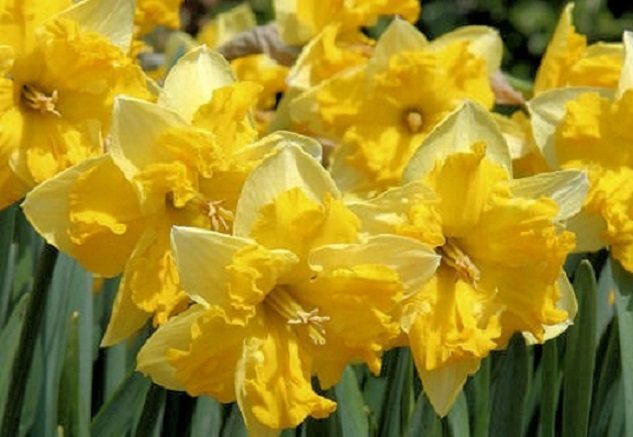

Variety - Trepolo
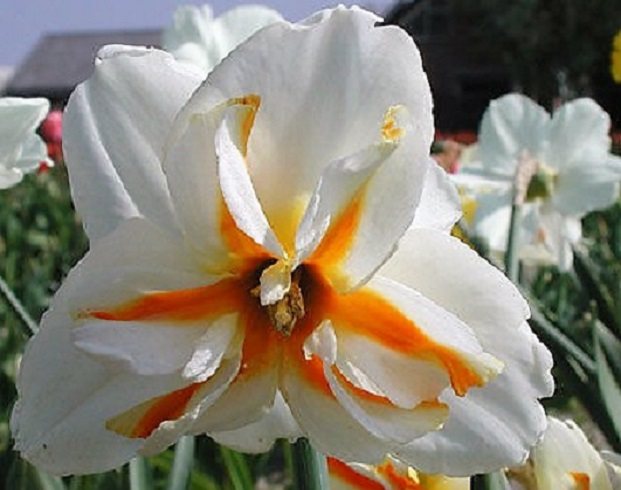

Sort - Berlin (Berlin)
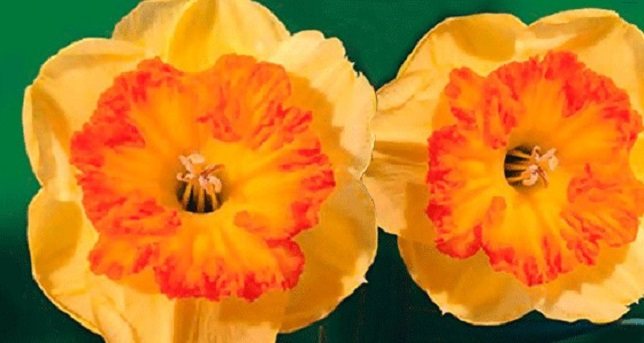

Variety - Flyer
Variety - Irene Copeland
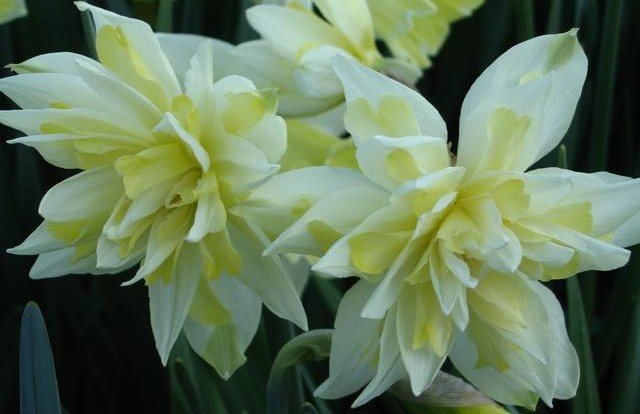

Selection of planting material and its landing
One of the varieties of daffodil
When selecting planting material, it is important to consider several of the most basic factors:
- Each bulb must be completely healthy;
- Be large and weigh at least 6 grams.
When disembarking, it is also worth considering some basic nuances:
- A drainage layer must be laid on the bottom of the selected pot, for which you can use brick fragments, expanded clay or pebbles;
- Do not completely immerse the bulbs in the soil, the third part must be above the surface of the soil;
- The most favorable time for planting is September;
- After placing the bulb in the ground, it is necessary to irrigate with plenty of water and tamp the soil a little;
- Place the container with the planted onion in a dark place, where it should stay for 12 weeks. At this time, the temperature of the selected room should not exceed 10˚С;
- When the first shoots appear, the plant can be placed on the windowsill.
When planting, you should pay attention to the nuances of the placement of the bulb, as well as the subsequent creation of favorable conditions for their germination.
Reproduction technique
Dividing the bulbs
The largest, healthiest tubers must be sorted. Each onion should be divided into 5 equal segments. On each cut, the top and bottom of the tuber should remain. For planting, you can choose one of the options:
- Using a solution of potassium permanganate, process the parts of the onion. Growth hormones can be used to stimulate growth. Then you should plant the planting material in a prepared container with soil. The substrate must be disinfected.
- Within 1.5 months, the separated areas must be stored in a room with a temperature of at least + 21 degrees. Next, you should move the slices to a cool room. The temperature should remain in the range from +10 to +12 degrees. The resulting bulbs can be planted in September. For the winter period, the area should be insulated with a thick protective layer of mulch.
- Parts of tubers must be placed in an organic stimulant for the development of the auxin group. For the next two months, planting material should be stored in the refrigerator.In the fall, you can plant bulbs on the site.
Separated daffodils will bloom their first buds in two years.
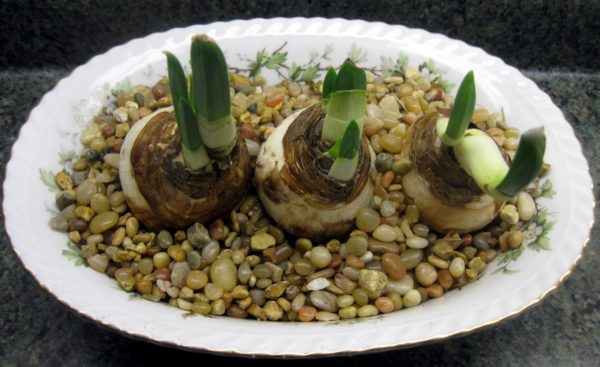

Daffodils can be propagated by dividing the bulbs.
Daffodil from seed
The method is rarely used for growing on site or indoors. The method is popular for breeding new breeding hybrids. For cultivation, you must choose exclusively freshly harvested, wet seeds. A characteristic protein coating should remain on the surface of the planting material.
It is not recommended to sow seeds deep into the ground. Shallow seed spread can be used. Direct cultivation in a flower bed often does not produce results. It is advisable to place the seeds in a container with agrarian vermiculite.
The optimum temperature for sprouting is about + 22 degrees. For two years, seedlings must be grown in a container. Then you can plant the crop in a large container or move the formed bulbs into the ground. The first buds will appear only after 5 years.
Using the technique, it is recommended to breed only simple daffodils. Hybrid representatives of the genus do not retain varietal advantages (double inflorescences and ebb).
Creating the most favorable conditions for the plant
For the narcissist, the most favorable will be a bright place on the windowsill, but without direct rays. Therefore, the plant will feel great on windows facing west or east. For the winter period, it is better to choose a south-facing window.
The characteristic of a soil suitable for a plant looks like this: loamy, fertilized, light with neutral acidity.
Indoor temperature also plays a very important role. The most acceptable option would be an indicator not exceeding 16˚С. It should be borne in mind that too dry air for the culture should not be allowed, so you should not leave it next to heating devices.
Favorable conditions for a narcissist consist in choosing the most suitable place, creating the right temperature and humidity.
Growing
The planting period should be chosen in accordance with the climatic conditions of the region. It will take about a month for daffodils to take root. The plant can be planted in early spring or late winter season. But for this you need to first stimulate germination. The bulbs should be stored for up to 2 months on the “no-freeze” refrigerator shelf. Otherwise, the tubers may not take root.
Landing features can be found in the video:
Soil mixture
The ideal soil composition for growing at home can be prepared with:
- alumina (sod soil);
- compost;
- peat;
- medium-grained, clean, river sand;
- chalk.
For cultivation, you can purchase ready-made soil. Please note that the optimum pH is 6.5.
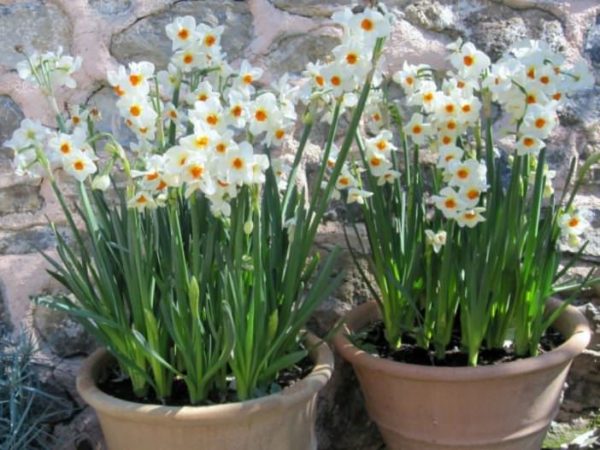

Soil with a suitable acidity level can be prepared at home.
Fertilizer
In an open area, nitroammophoska, bird droppings (granular, soluble), ash and bone meal can be added to the soil. Fertilizer is advisable to use when loosening the earth.
Subsequent dressings should be applied as needed. The weakened soil can be fed in the spring after the first shoots appear with ammonium nitrate. The high content of potassium and phosphorus in fertilizers will help to activate flowering and the formation of bulbs.
Mineral compounds are not recommended to be used according to the instructions. It is advisable to divide the concentrated product into two applications, reducing the dose.
Fresh dung is harmful to daffodils. Organic fertilizer can be a source for the propagation of onion hoverflies. The pest will destroy the plant.
Growing a daffodil in a container
Taking care of a plant indoors is not difficult. The plant feels comfortable on darkened windows.For the accelerated development of buds, you can place the container on a lighted windowsill.
It is necessary to fertilize the soil at the stage of bud production and after the wilting of the inflorescences. To extend the flowering period up to three weeks, it is advisable to transfer the flowerpot to a loggia or balcony.
Unlike most houseplants, water the crop directly into the pan. It is advisable to use settled water at room temperature.
At the stage of wilting of inflorescences, it is necessary to reduce the frequency of watering. When all the leaves turn yellow, you can stop moistening the soil.
The plant is very difficult to tolerate excessively dry air. Avoid direct proximity to heating devices. Near the flowerpot, you can spray water or purchase an apparatus for artificial humidification.
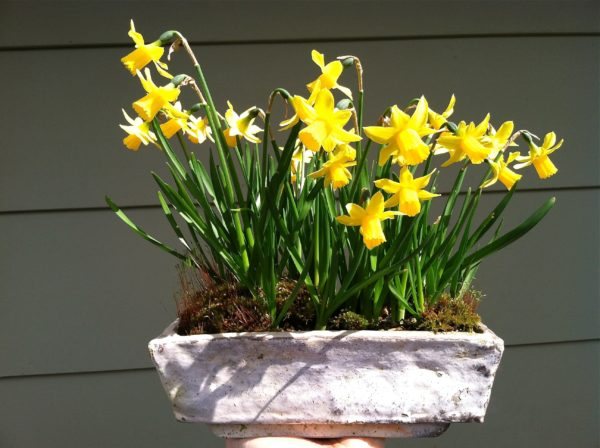

Daffodils can bloom profusely in containers.
Proper watering and fertilization
Caring for the plant will not be difficult. Before flowering, it is worth placing the pot on the sunny side, since under the influence of rays, the buds will bloom much faster.
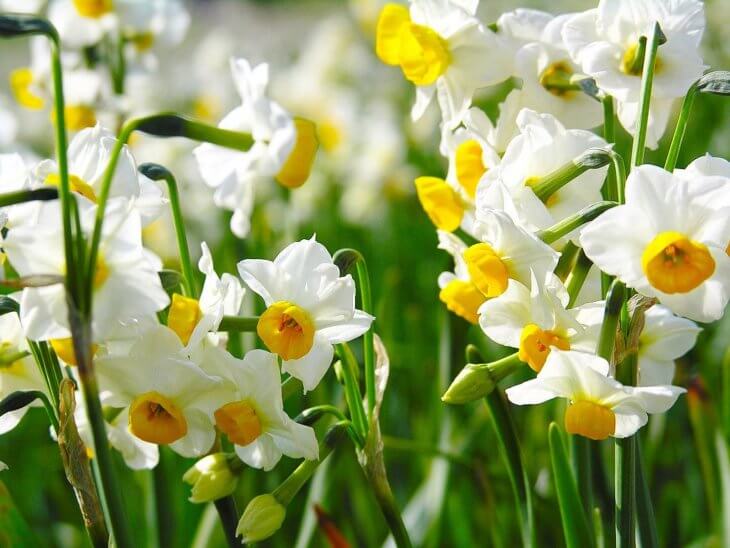

Blooming daffodils after fertilization
For fertilization, the most favorable time is considered the period of formation and development of buds and the time after the end of flowering.
It is advisable to water only in a pallet. Be sure to use water brought to room temperature for this.
After flowering ends, it is necessary to reduce the regularity of watering, and after the foliage turns yellow, stop it altogether.
Caring for a daffodil consists of timely watering and fertilization.
Why does the plant not bloom
There are several reasons for the violation of the process of formation of inflorescences:
- High level of soil acidity.
- Planting in groups with other plants. Narcissus is a perennial culture. Over time, the roots of the flower grow. The close proximity of other green spaces can cause root entanglement. If the formation of inflorescences has slowed down, it is necessary to plant the daffodil.
- Depleted soil and lack of top dressing. Growing outdoors is often difficult. Heavy rainfall can wash out all the beneficial ingredients. Therefore, fertilizer must be applied before bud formation begins.
- Nitrogen components. Feeding with a chemical element reduces the number of inflorescences.
- A sharp drop in temperature in winter. Especially dangerous frosts in a snowless winter. For insurance, you need to cover the planting site with mulch.
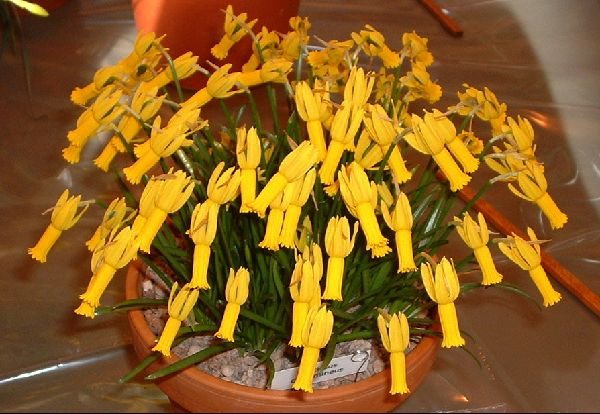

The absence of inflorescences indicates inadequate care.
Common diseases of narcissus
No plant is complete without disease. This also applies to the narcissist. Most often, the plant suffers from an invasion of fungal and viral diseases. The main reason for this is poorly prepared planting material.
The same applies to gray rot and fusarium, which appear on plants grown from a diseased bulb.
In order to prevent the occurrence of these troubles, it is necessary to carefully check the bulbs before planting, and in no case should suspicious specimens be placed in the ground.
Basically, all diseases of daffodils are manifested from poorly prepared planting material.
Classic problems of narcissists
Failure to comply with the storage conditions of the bulbs, late extraction or insufficient processing can cause the appearance of fusarium rot. Distinct brown markings appear on the tubers.
At the initial stage, you can save the planting material with a fungicide solution. A badly damaged tuber must be disposed of.
Excessive use of organic matter causes sclerocial rot. Affected daffodils must be burned. A sharp cold snap and excessive humidity can cause gray rot in various parts of the plant.
Nematodes are especially dangerous for daffodils. There are two subspecies of pests that affect the tubers and stems of the daffodil. The plant cannot be cured. Culture should be destroyed.
As a preventive measure, it is necessary to carry out heat treatment of the planting material. Before planting, the soil must be disinfected with copper sulfate.
Narcissus fly damages stems and leaves. Insecticide "Intavir-S" should be used to control larvae. Peat can be used as a protective cover.
It is easy enough to use the help of natural "patrons" of daffodils. Planting a crop next to nasturtium, marigolds or marigolds will scare away pests.
Description
Narcissus is a spring flower: it pleases with its beauty one of the first after a long, dull winter. These flowers are good outdoors, but they can also look great at home in a pot.
Daffodils grow small, have white and yellow color, delicate petals and always dark green leaves. Their buds can be either of a simple structure or terry: the latter are the most decorative. Varieties with a two-tone yellow-white color have already been bred. More recently, there is also a variety that has a pink outer edge. The flowering period is from December to March.
Narcissus is a bulbous plant. Its peculiarity is the presence of two buds of renewal on the bulbs: each of these buds is at its own stage of development. Above, the bulbs are covered with a brownish skin, elongated in shape, pear-shaped.
Varieties
Today, the scientific botanical world has more than 30 different varieties of daffodils, most of which are suitable for home cultivation. Below is a small overview of the most popular varieties.
Paper
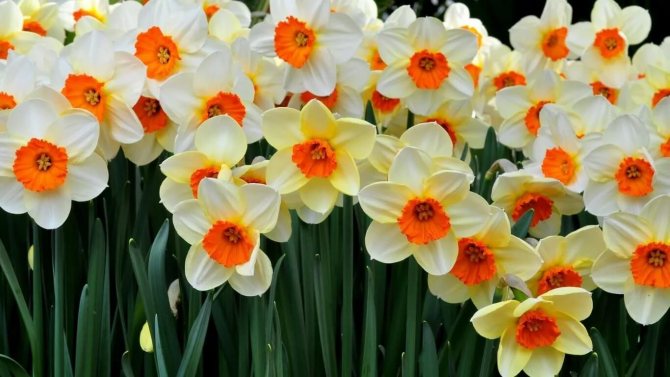

Probably the most popular indoor cultivar. The flower boasts many snow-white buds located on one straight peduncle.
Magnet
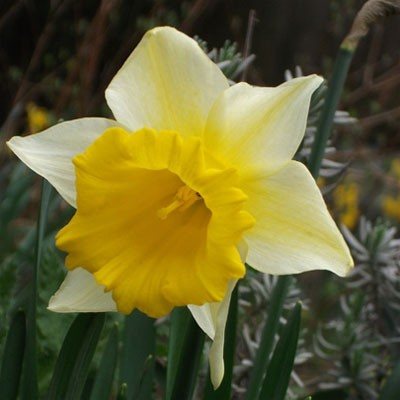

A wonderful yellow daffodil that can bring brightness and liveliness to the most dull interior.
Avalanche
An unusual-looking flower with two-colored petals: the middle of the bud is yellow, and the edges of the petals are white. Despite its exotic appearance, the variety is unpretentious.
Florists also praise the Little Pearl, February Gold and Snowball varieties.
Aromatic properties
Translated from Greek, the word "narcissus" means "intoxicating." Perhaps that is why it is the same root with the word "anesthesia". This was facilitated by the strong intoxicating sweet aroma of the flower, due to the presence of essential oils, which are actively used in cosmetology.
But this is in the past - it gradually lost its former popularity, tk. cheaper synthetic flavors appeared. This amazing flower has found its application in medicine.
- Its medicinal properties can be useful for:
- leukemia;
- radiculitis;
- pneumonia;
- prostatitis and adenoma;
- healing wounds.
Important! Narcissus can cause severe allergic reactions or migraines.
Growing conditions
We will find out what conditions this flower needs and where in the house it is better to put a pot of daffodil.
Location and lighting
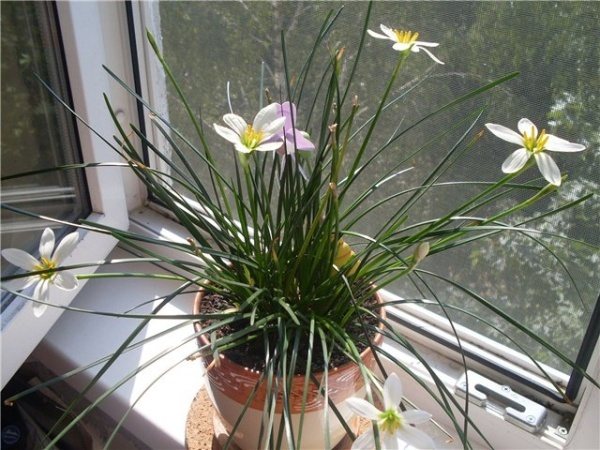

A daffodil can grow in the shade, however, it will bloom better in the sun. Keep this feature in mind when choosing a place for this plant. The more abundant the lighting, the longer the flowering period: however, you should not keep the daffodil in the pot in direct sunlight.
Temperature and humidity
The flower is completely picky in terms of temperature, it can be successfully grown even in relatively cool rooms. However, higher than + 15-18 degrees, it is not worth raising the temperature in a room with growing daffodils: in this case, they may refuse to bloom.
The flower is more demanding to the level of air humidity: a dry atmosphere does not suit it. Place the plant at home away from working heating radiators. It is advisable to place a container filled with water next to the pot.
Soil composition
In gardening stores, you can buy a special substrate for daffodils - it is optimal for growing them indoors. Note that you can plant a flower in garden soil taken from your own plot.
To make the substrate more nutritious and friable, it is recommended to add sand, dry clay or sawdust to it. The structure of the substrate should be crumbly, loose, light. Dense soil is not suitable for the plant, since it cannot provide sufficient air access to the roots. In such conditions, the plant is often affected by a fungus.
Planting domestic daffodils can also be done in perlite, small decorative stones. This technique is often used when it is necessary to receive flowers for the holiday - March 8, for example. There is enough nutrition in the bulb, and it develops quite well with regular watering.
Pot selection
Choose a small pot (about 15 cm), 10-13 cm wide. Several onions can be grown in one container, if they are small. As for the material, it is better to take clay or ceramics.
If the variety is miniature, it can be grown in a small capacity: less than one and a half to two times the standard one. If you want to grow a whole lawn of daffodils at once, you can take a shallow wooden box as a container.
An excessively large, wide or deep container is absolutely not suitable for daffodils. In such conditions, the plant may not even bloom: the roots take a long time to develop the earthen coma.
The pot must be equipped with holes for draining the water. Stagnation of moisture in the soil is fraught with putrefaction and fungal diseases for daffodils.
Spread
Most species of daffodils are native to the eastern Mediterranean and the Middle East. Several species come from Asia and China. It grows everywhere in Europe and Asia. This flower, unpretentious in cultivation and care, is one of the first to bloom. It will be a great addition to any spring flower garden.
Easily adapts to external conditions. It can be planted in the shade or in the sun, but the flower will look much better if it gets enough sunlight. The soil can be neutral. The main condition is good drainage to prevent stagnation of water.
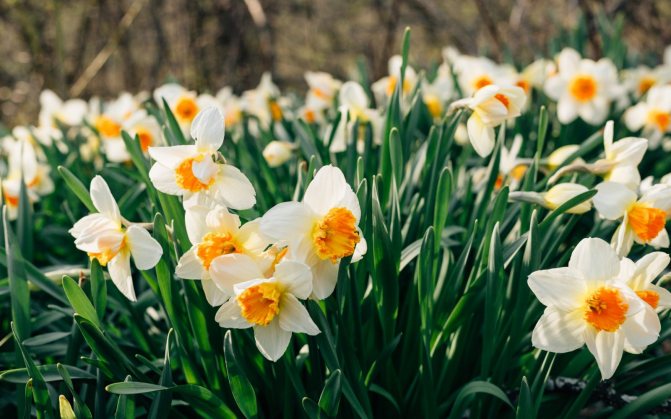

Many myths and legends are dedicated to this amazing plant. In the East, a flower is often compared to the bottomless eyes of a beloved. In ancient Greece, the daffodil was a sign of grief, and in ancient Rome, the winners from the battlefield were greeted with these flowers.
Europe is considered a talisman that attracts love. And for the Chinese, daffodil is an invariable attribute of the New Year holidays. It symbolizes wealth and prosperity.


If we turn to the language of flowers, then the daffodil symbolizes selfishness and narcissism, like the eponymous youth from the legend.
Landing features
We will learn how to properly plant daffodils in a room.
Bulb selection, preparation, timing
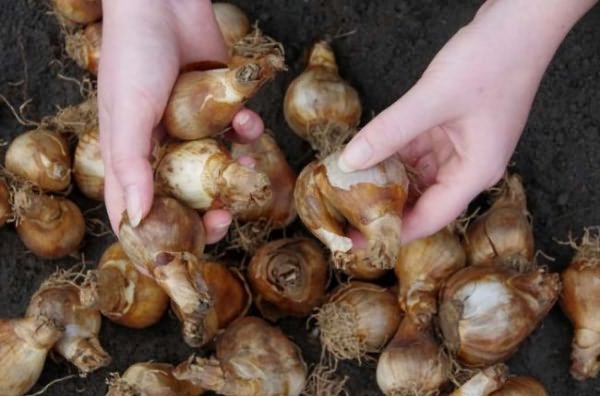

In order for the daffodil to take root well and please with long flowering, choose hard and rather large bulbs. There should be no damage, holes, spots, putrefactive areas on the planting material.
After purchasing the bulbs, it is recommended to plant them in the pots as soon as possible. Ideally, planting material should be purchased just before rooting.
There is still a need to store the bulbs before planting, place them in a dark, ventilated and dry place. It is not worth storing in a too warm and humid room, as the bulbs may start distilling ahead of time. Yes, and the defeat of the fungus in such conditions is not excluded.
Timing
The planting period of daffodils depends on when the owner plans to enjoy the flowering of the plants. If you want flowering to happen traditionally in winter, planting should be done in early September. If flowering is planned for spring, planting is done in November-December.The exact timing depends on the variety.
Process
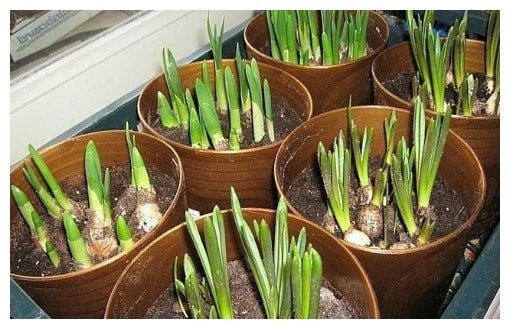

- Place drainage on the bottom of the selected container - small pebbles, pebbles, expanded clay with a layer of about 3 cm. Fill the container with the substrate.
- Place a few onions on top and press them a little into the soil. The onions should look a little over the edge of the pot. Each onion must be planted at a distance from the neighboring one - they must not be allowed to stick together.
- Pour water over the soil, avoiding flooding.
- Place the pot in a dark room with a temperature of + 3-8 degrees for three months to root the bulbs. Note that some varieties do not need in the cold season (Ziva, Paper).
- At the end of the three-month period, the pot is transferred to the living room and proceeds to standard grooming procedures.
Indoor daffodils: growing at home
Daffodils are fragile, charming, unpretentious flowers. Nevertheless, their health and flowering depend on the accuracy of the cultivation rules. If all the conditions for planting and further care are met, daffodils will delight you with gorgeous flowers from mid-winter to late spring.
Choosing a daffodil pot
- Daffodils feel comfortable in medium-sized ceramic pots: up to 17 cm high and up to 14 cm wide. Several bulbs can be placed in one pot.
- The pot is chosen with drainage holes. This prevents the development of rot on the bulbs, which can happen in conditions of stagnant moisture in the soil.
- Choosing a pot that is too wide or too deep will result in a prolonged lack of flowering.
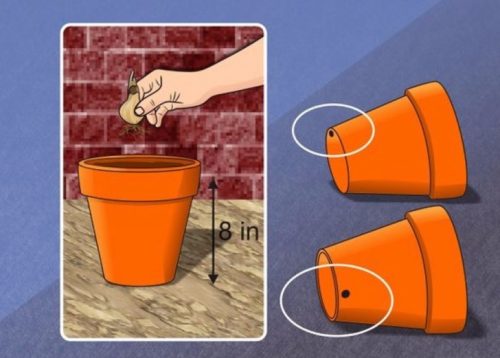

Potted daffodil soil requirements
You can plant daffodils in special soil for bulbous plants, but there is nothing wrong with planting a plant in a garden substrate diluted with sawdust and sand. In any case, the earth should be loose and crumbly, without breasts and stickiness. Otherwise, the bulb will be poorly saturated with oxygen, which will lead to the development of diseases.
How to plant a daffodil in a pot correctly
- The process of planting daffodil bulbs should be carried out in November.
- A drainage layer is laid on the bottom - brick chips, expanded clay, small stones. Layer thickness 3-4 cm.
- Then the substrate is poured up to the pot edge.
- The bulb is pressed into the ground, leaving ¼ on the surface. Several bulbs can be planted at the same time. So, in a pot with a diameter of 4-5 cm, you can easily plant 4-6 medium-sized bulbs.
- When planting in groups, make sure that the bulbs do not touch.
- Then watering is carried out and the flowerpot is placed in a cool room, where the temperature is about 4-8⁰С warm. The duration of the stay of the bulbs in such conditions is three months.
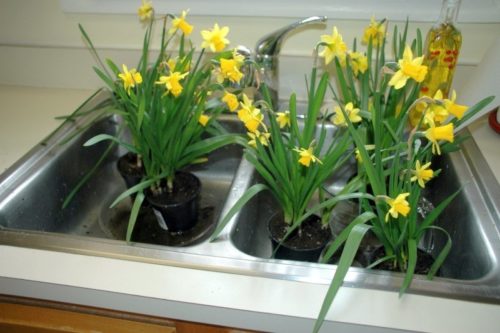

How to care
Watering
The first time the flowers are watered immediately after planting. Water sparingly while rooting: twice a month should be sufficient.
After transferring plants from a cold room to a living room, watering is carried out as the soil dries out. When the daffodils begin to bloom, the frequency and volume of watering increases. At the end of flowering, they decrease again. When the leaves turn yellow, the moistening of the soil stops completely.
Use water at room temperature and separated. The best way to water is through the pallet.
Top dressing
For lush and long flowering, as well as good health, it is recommended to feed the indoor daffodil. Compositions with nitrogen and potassium should be used.
The first feeding is done when the shoots appear. The second - when buds appear, then every two weeks. During the flowering period, daffodils are not fed, however, as well as after the cessation of watering.
Pruning
The procedure is performed after the daffodils have faded. Dry buds are carefully cut, while the green part must first dry completely on its own. After the leaves and stems wither completely, they are cut with clean scissors at the root.
After flowering
After the final pruning, the pot with the bulbs remaining in the ground is placed in a cool and dark place.If the flower was sick in summer or was flooded with pests, it is better to get the onions out of the ground and examine them for rot and damage. Throw away the defective planting material immediately before it has infected the rest.
In winter, store the bulbs in a dry paper tight bag or a natural cloth bag. The bulbs dug out of the pot for the next year should be rooted in the open field. And for planting in a pot, you need to purchase the onions again.
Indoor daffodil, grooming
Having planted a daffodil, you do not have to make titanic efforts so that it blooms beautifully and does not get sick. Adhering to basic agricultural techniques will allow you to admire the delicate flowering of daffodils right at home.
On a note! Daffodils are very sensitive to various ethers and gases that produce fruits and most plants. Therefore, try not to place a flowerpot with other indoor flowers nearby.
Watering and feeding the daffodil
Home care should be regular for a daffodil, especially watering.
- For the first time, the bulbs are watered immediately after planting in a pot. While the rooting process is underway during the cold treatment period, watering is carried out a maximum of twice a week.
- When the daffodils "move" into the room, they are watered regularly as the earthen coma dries out.
- The peak of watering occurs when the daffodil blooms, and when the flowers fade, watering is gradually reduced.
- For irrigation, water well filtered or settled for 24 hours is suitable.
- It is important to carry out top dressing - without it, the process of rooting and bud formation will be difficult and lengthy.
- When the sprouts hatch, potassium-nitrogen fertilization is carried out with liquid mixtures.
- When the buds appear, every two weeks the flower is fed with complex fertilizer.
Advice! When the daffodil begins to bloom, growers are advised to move the pot to a cooler place with a temperature of about + 12 ° C. They claim that this will extend flowering up to 21 days.
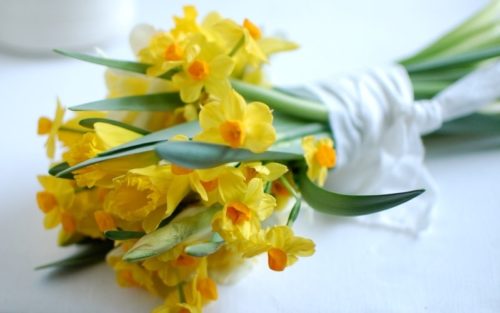

Pruning and caring for a daffodil after flowering
Only completely dried inflorescences are subject to pruning. You do not need to touch the deciduous outlet - it should dry out on its own. Until this time, the plant is rarely watered and a little fertilizer is taken out every 12 days. And only when all the leaves begin to die off, they are cut off with a disinfected knife.
After that, the bulbs are removed from the soil and sent to storage in a cold room. Before that, they must be examined for diseases - specimens with signs of decay are disposed of.
On a note! Forcing a daffodil at home from one specimen can be carried out for three years in a row. By the end of this period, flowering will become scarce and short-lived. But don't get rid of the bulbs - plant them in your garden.


Daffodil indoor, reproduction
New specimens are obtained by separating the babies from the mother's bulb at the time of transplantation. You can also divide an adult bulb into segments by treating the bulb and tools with potassium permanganate before doing this. Then the parts are kept in a warm room for 30 days and planted in separate pots.
Protection against diseases, pests
Most often indoor daffodils suffer from fungal diseases. A similar attack happens due to waterlogging, the content of the bulbs during storage in warmth and humidity. The main measure for preventing fungal diseases is preventive spraying of bulbs with fungicides, as well as proper care of the plant.
Among insects, daffodils are most often affected by ticks, bulb flies and nematodes. Usually, infection occurs through insufficiently disinfected soil. It is especially dangerous to take garden soil and not sanitize it, immediately using it for planting. If pests are bred, it is necessary to use insecticides to destroy them.
We learned how daffodils are grown at home.As you can see, these unpretentious plants can bloom and develop quite safely even in greenhouses. Observing simple care measures, you can easily get healthy, actively blooming daffodils on the windowsill at home.
In the gardens of our region, there are many beautiful flowering plants, the beauty of which captivates the imagination of people and takes them into a world of romance and inspiration. Among such peduncles, a special place is occupied by captivating daffodils. Their refreshing beauty enchants and mesmerizes, making them the most beloved and popular colors. And it doesn't matter if there are several single flowers blooming in the garden or a sea of multi-colored blooming daffodils is raging.
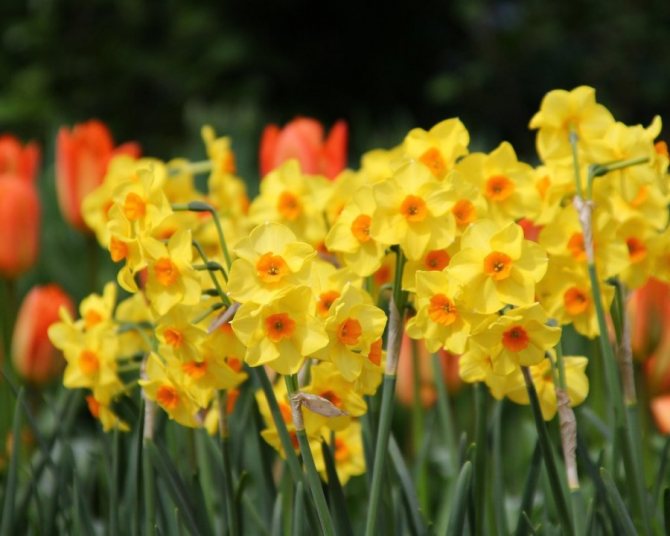

Daffodils appear early in gardens, along with early varieties of tulips and hyacinths. They do not represent a homogeneous group - if you pay attention to the numerous photos of daffodils, you can immediately see that all flowers differ in color and shape.
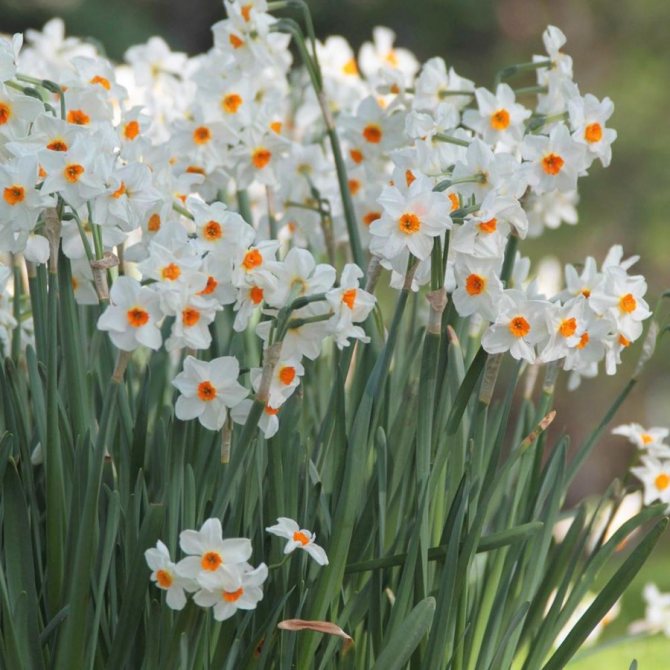

And although the plant is not considered to be very capricious or requiring special attention, growers should not let its cultivation take its course. Only a true lover of daffodils can provide decent flower care and admire their pets in all their glory in the spring. Therefore, it is better to familiarize yourself with the rules of planting and leaving in advance.
To find out more information about houseplants, you cannot do without a site with a lot of instructions and photos!
Depending on the variety, each daffodil bush consists of a dense bulb (large, medium or small), ribbon-like leaves (from 2 to 4 pieces) of varying length and density, a stem and the flower itself.
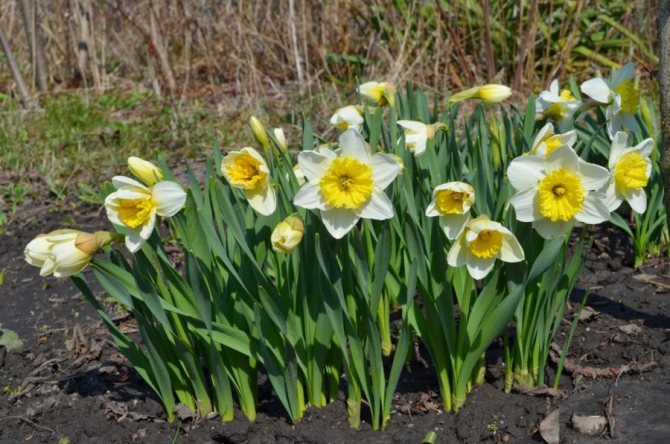

Bulbs come in different shapes - oval, ovoid, round, and some varieties form a nest of several bulbs. The leaves of daffodils grow from a bulb, the stem is straight and leafless.
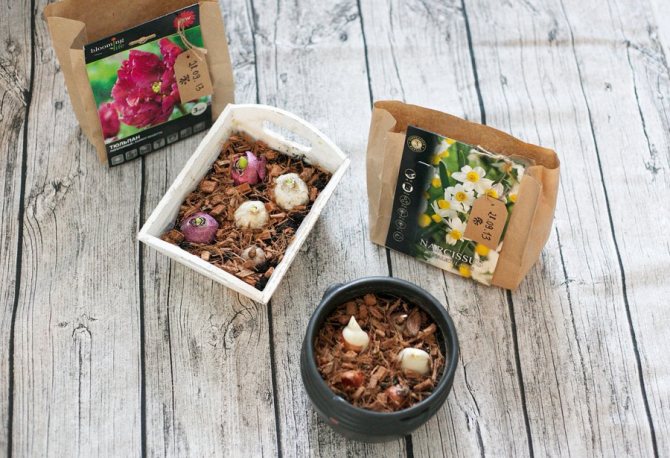

Inflorescences can be single, many varieties have peduncles, crowned with several flowers at once - from 2 to 8 buds.
Container and soil for a domestic daffodil
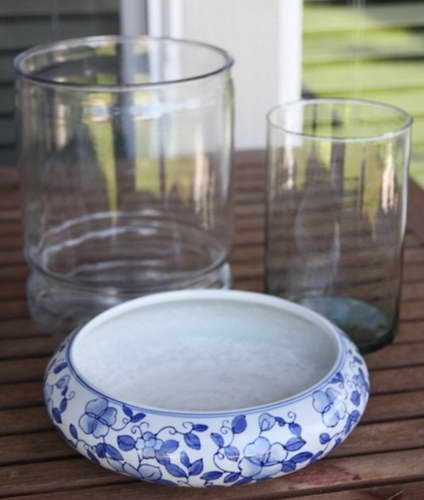

Container for distilling daffodils photo
The roots need enough space to grow normally. Use large pots: 15-20 cm in diameter and about 30-32 cm deep. These settings are suitable for growing large bulbs. For miniature varieties, they are cut in half. Better to take ceramic or clay pots, glass bowls. Wooden crates can be used.
The soil is required to be soft, but not sticky. You can purchase a special soil mixture (consists of clay, river sand, fertilizer and sawdust). Or take 2 parts of garden soil and 1 part of river sand.
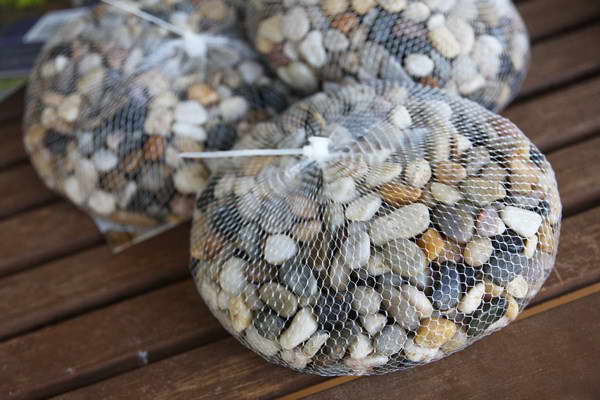

Even decorative pebbles are suitable for forcing daffodils.
For distillation for the holiday, daffodils are planted simply in decorative stones, because the bulbs have a sufficient supply of nutrients and the plants develop well provided sufficient watering.
The main types and varieties of daffodils
The most favorite and common types of this flower are the following:
- tubular - the length of the middle, the so-called tube, and the petal of the inflorescence are the same, sometimes the tube is longer than the petals;
- large-crowned - a characteristic feature is that the length of the crown of the inflorescence is approximately half the length of the petal;
- small-crown - the length of the crown is only a few millimeters;
- split-crown - the middle of the flower is of different sizes and lengths, the main feature is that the crown looks torn or fringed. Very spectacular and beautiful inflorescences;
- terry varieties. Also beautiful and unusual plants with large flowers. Some terry varieties have very large inflorescences and the stem does not withstand such a large and heavy flower, so a special support is placed for them;
- cyclamen - the shape of the inflorescence resembles a cyclamen. The middle of this variety is long and thin. An early variety of daffodils;
- Jonquillia is a late variety that has several small inflorescences on the stem.
Indoor daffodil: suitable varieties for growing at home
Most species and varieties of daffodils are unpretentious and lend themselves well to growing at home. Consider the popular representatives of the genus:
- Tubular. A single, but rather large, yellow-milky bud is produced. Bulb more than 5 cm in diameter. Breeds well. The chic Gin and Lime has a delicate lemon crown that blends seamlessly with the emerald eye.
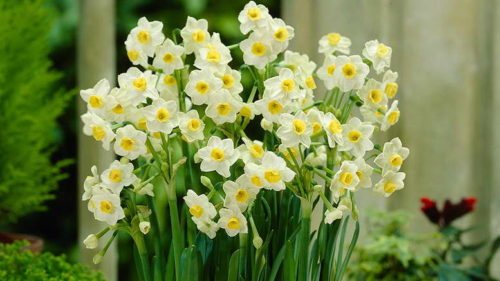

- Large-crowned. View with a corrugated and short crown, small onion. Delicate Jeanine has a scarlet crown, a long flowering period, and a persistent aroma.
- Small-crowned. Long, cream-colored crown. The bud size is medium, the aroma is delicate, the flowering is short-lived. The amazing Sabine Hay strikes the eye: the orange-colored perianth contrasts with the red crown. Differs in late flowering.
- Terry. The unique varieties of the group are terry. The Tahiti cultivar has flowers that reach 10 cm in diameter. The honey-colored perianth is combined with a yellow-red scallop.
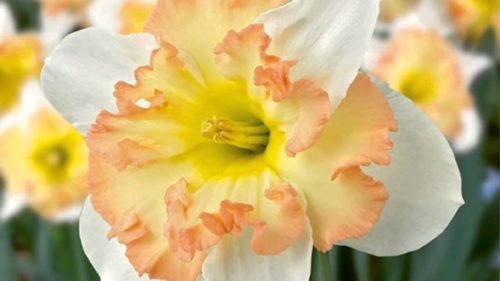

- Triandrus. A group of undersized varieties. Three flowers appear on short peduncles. Ice Wings flower - with white petals and a large crown, blooms for a long time and is extremely beautiful.
- Cyclamenous. A single flower that looks like a simple cyclamen. Cotinga cultivar - with milky white petals and a peach crown.
- Jonquillia. A late blooming species with dark emerald greens and multiple bowl-shaped flowers. Suzy has a fiery red crown and golden perianth.
- Bulbokodium hybrid. Miniature daffodils that resemble bells.
- Split-crown. A distinctive feature of the species is a fringed crown and petals. The flower of the Papillon variety resembles a white and yellow butterfly. And the Palmares variety blooms with white and pink flowers.
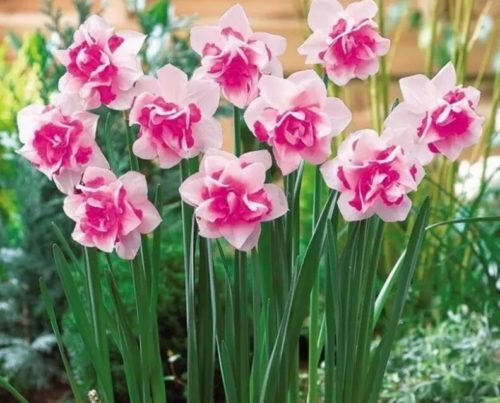

When is the best time to plant daffodils
Flower bulbs must be planted in late September or early October, depending on weather conditions. The selected area should be well moisturized. If the autumn is dry and without rain, the soil should be well saturated with settled rain water.
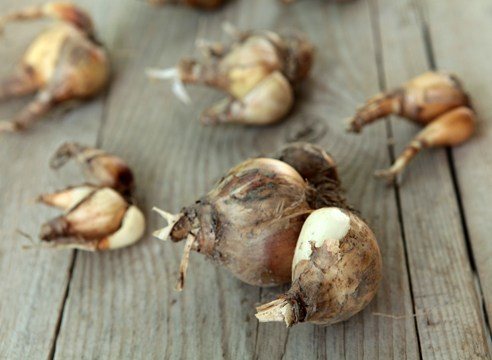

Before planting, the soil must be loosened and saturated with top dressing, for example, humus, compost, peat, superphosphate, wood ash.
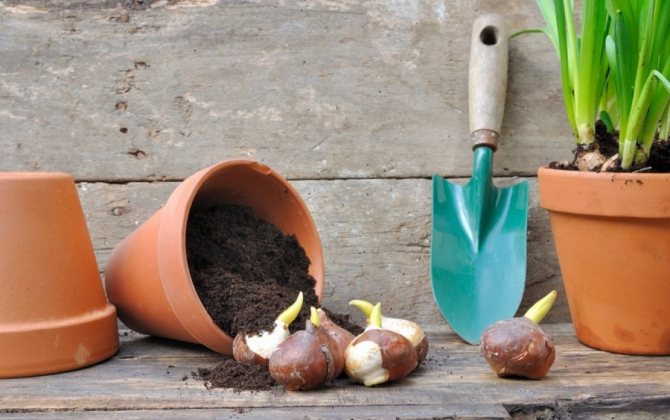

Do not add fresh manure to the soil for planting bulbous flowers - the planted bulbs will burn and die. It is also recommended to add a little river sand to the soil.
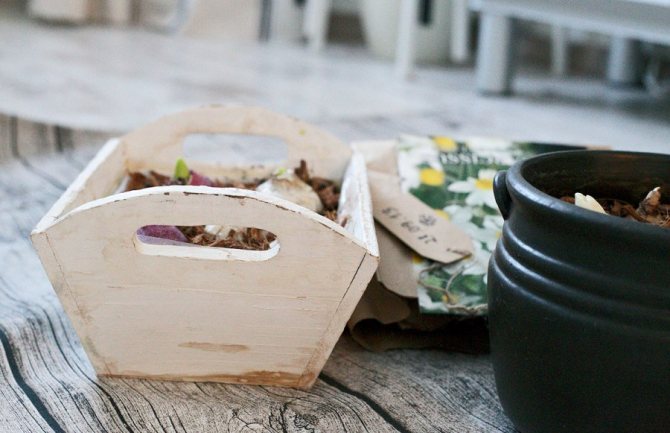

When the soil becomes moist and sufficiently saturated with nutrient medium, you can start planting. First, you need to inspect and sort out all the bulbs, set aside soft, sick or damaged ones (having spots or cuts with a shovel). All healthy bulbs are recommended to stand for half an hour for disinfection in a weak solution of manganese or fungicide.
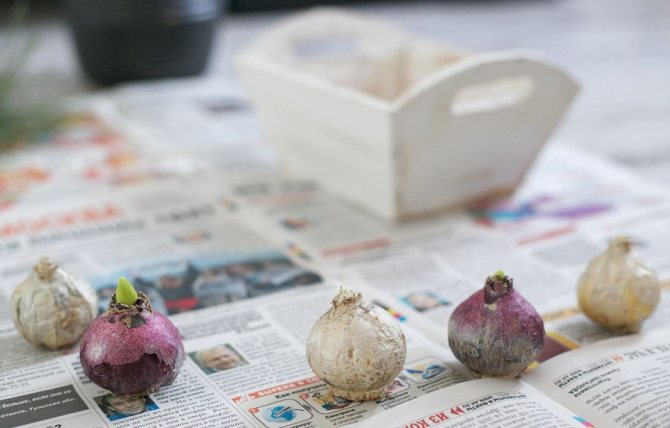

A small hole should be prepared for the onion, corresponding to approximately three of its diameters. The distance between the holes depends on whether you plan to plant flowers for 1 or 2 years or for 4-5 years.
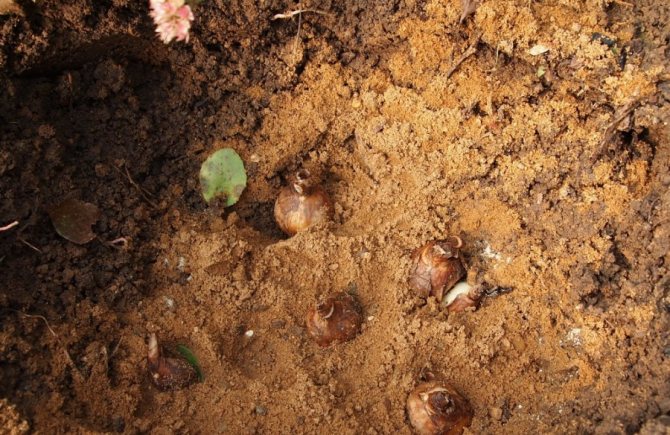

If in a couple of years it is planned to dig them up, then you do not have to worry that the onion will give many children and it will be cramped for them in the ground. Therefore, in this case, 7-10 cm between the holes will be enough.
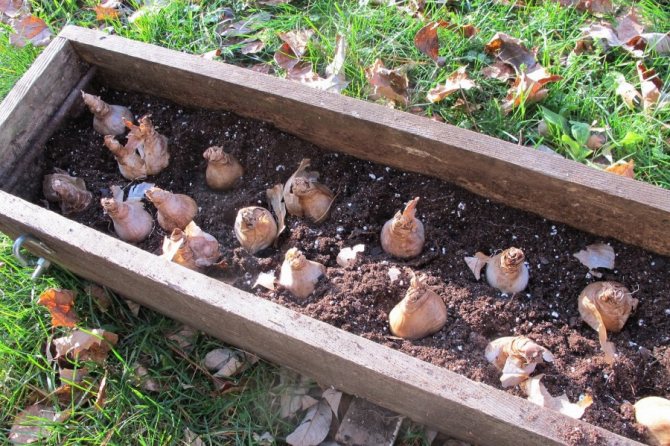

If a flower bed with daffodils will be in the same place for 5 years, care should be taken to ensure that the little children that appear at the flower during this time have enough space and nutrients from the soil. Therefore, it is worth making holes every 15-20 cm from each other. After planting daffodils, cover the area with fallen leaves.
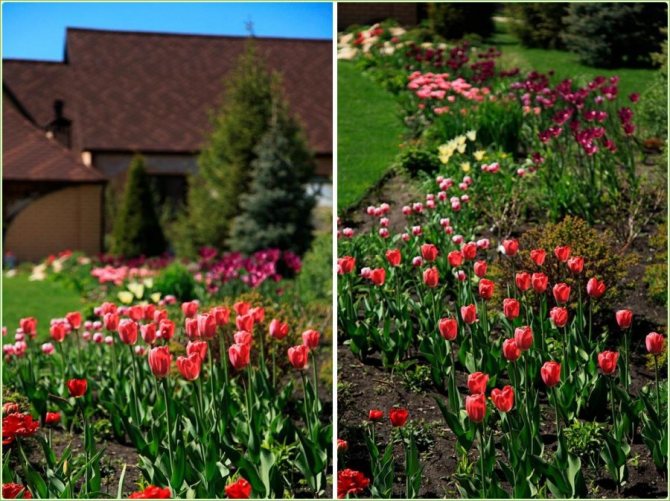

How to plant a daffodil, basic requirements
Daffodils are unpretentious. However, in order for the plant to take root well and delight you for a long time with its enchanting flowering, it is necessary to adhere to certain planting and care rules. When they are performed, daffodil flowers can be admired from winter to mid-March.Sometimes there are complaints that the plant does not show any signs of illness and damage, but very little or no flowers. Most often, the reason for such troubles lies in the wrong approach to planting.
How to choose a daffodil pot
The pot for planting daffodils should be short (about 15 cm), medium in width (from 10 to 13 cm). In one such pot, you can plant from two to four bulbs, depending on their size and variety. It is best if it is a clay or ceramic container.
Important! If the pot is tall or too wide, the plant will not bloom. There must be holes on the bottom of the pot. They serve to ensure that excess water can escape from the container during irrigation. Otherwise, moisture will stagnate in the soil, which will lead to rotting of the plant.
What should be the soil for planting a daffodil
Specialty daffodil primer can be purchased at flower shops. However, this plant will take root well in ordinary garden soil. In order for daffodils to bloom better, it is recommended to add a little sawdust, river sand or clay to the ground.
The ground should be soft and crumbly. If there are breasts in the soil, and soil particles begin to stick together, the soil will not receive enough oxygen, which will lead to fungal diseases of the plant. It is recommended to fertilize the soil with minerals or wood ash.
Did you know? White paper daffodils can be placed in a glass beaker with gravel. In this case, the top of the bulb should look out a little (about 5 mm), and the bottom (about 1.5-2 cm) is covered with water.
How to plant a daffodil correctly
We have already figured out the choice of capacity and soil, now we will decide on how to plant daffodils correctly. Drainage (small pebbles, pebbles) must be placed on the bottom of the pot with a layer of about three fingers. This will provide better oxygen circulation and the ability to remove excess water during irrigation. Next, the container is filled to the edge with soil. The bulbs are placed on top and pressed lightly into the soil. The top of the planting material should protrude slightly beyond the edge of the pot.
The number of bulbs placed in a pot depends on the size of the pot. For example, in a container with a diameter of 9 cm, you can place three onions measuring 10-11 cm. In no case should the bulbs be allowed to stick together. After planting, the soil is watered with water. You do not need to fill the pot, otherwise the planting material will rot or start to hurt. In order for the bulbs to take root, the containers are placed in a cool (from +8 to +3 degrees), dark place for three months. Then they are transferred to the room. Bulbs of varieties Ziva and Paper do not need a preliminary cold period, they can be placed on the windowsill immediately after planting.
Planting time depends on the desired flowering period: if it is necessary for the plant to bloom by winter, they are planted in early September, if by spring - at the end of November or early December. In order not to miscalculate, read the description of the variety, how long it takes for the plant to root and prepare for flowering.
How to provide favorable conditions for flowering
In order for the daffodils to bloom luxuriantly and amicably in the garden, they should be fed several times. Several dressings are recommended during the season:
- the first feeding should be done after the first shoots appear. You should take any mineral fertilizer (30 g per 1 square meter), dilute in water and fertilize green sprouts;
- the second fertilizer is recommended to be done during the budding of the bush (20 g per 1 square meter); the third feeding should be done after flowering. This will require phosphorus and potash fertilizers.
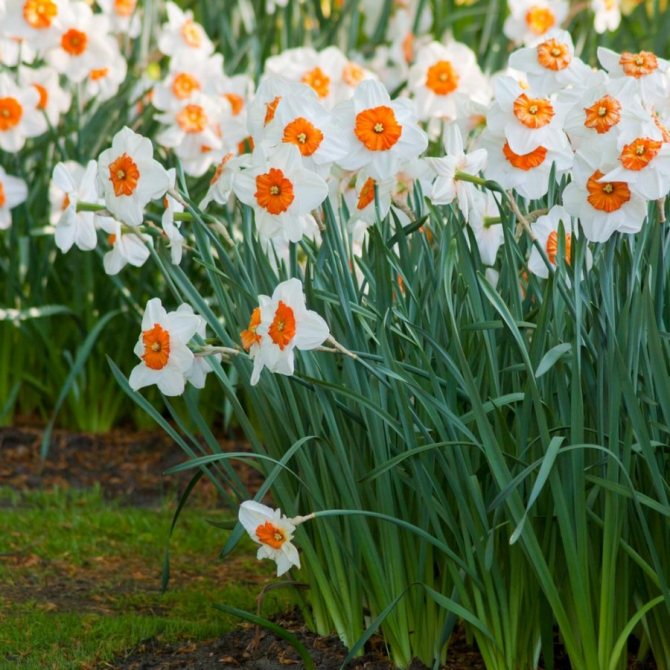

Otherwise, plant care is reduced to removing weeds, loosening the soil a little and watering the flowers regularly. It is recommended to water them from below, without touching the leaves and even more so the flower.
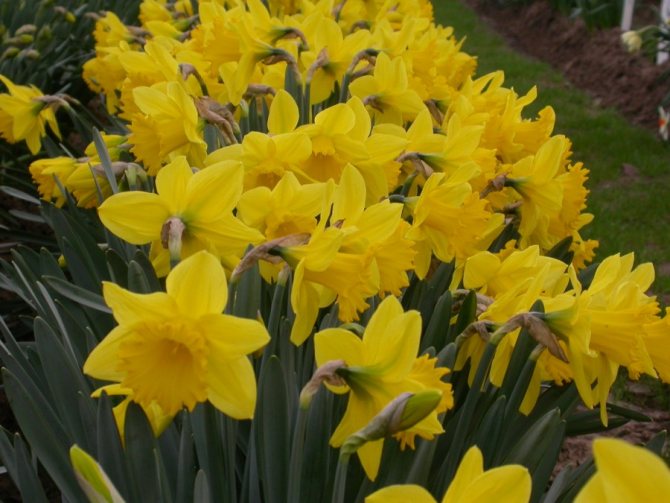

Narcissus on the plot
Daffodil flowers are among the first to appear in the garden.Inflorescences bloom simultaneously with crocuses, tulips and hyacinths. It is quite easy to grow an unpretentious crop outdoors.
It is enough to choose the correct zone for planting tubers. Daffodils thrive on lighted, loose and fertile soils. A week before planting, you need to prepare a flower garden. In the flowerbed, the soil should be thoroughly loosened. You can add medium-grained sand and humus (at the rate of 10 liters per 1 square meter).
Fresh dung can kill daffodils. Therefore, it is strictly forbidden to use the component during planting or for fertilization.
Excessive alkalinity can be corrected by adding dolomite flour. The increased acidity is reduced with the help of crushed charcoal.
When growing daffodils, consider crop rotation. It is not advisable to plant a flower in an area after lilies, tulips and other bulbs. Perennial representatives of the flora - chrysanthemums, phloxes and asters - also deplete the soil. You should choose a site with last year's legumes or cereals. The soil is ideal after cucumbers or peonies.
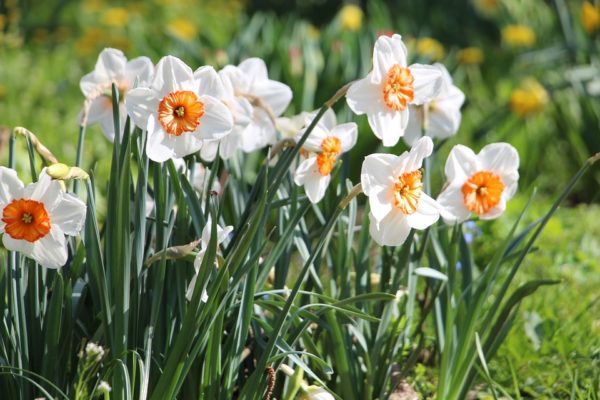

It is not recommended to plant daffodils after bulbous plants.
When to dig up the bulbs
Daffodils can stay in one place for 5-6 years, after which they are recommended to be dug up, divided into separate bulbs and transplanted to another place. If this is not done, the newly appeared children will interfere with each other's development, and the inflorescences will become small and lose their attractiveness.
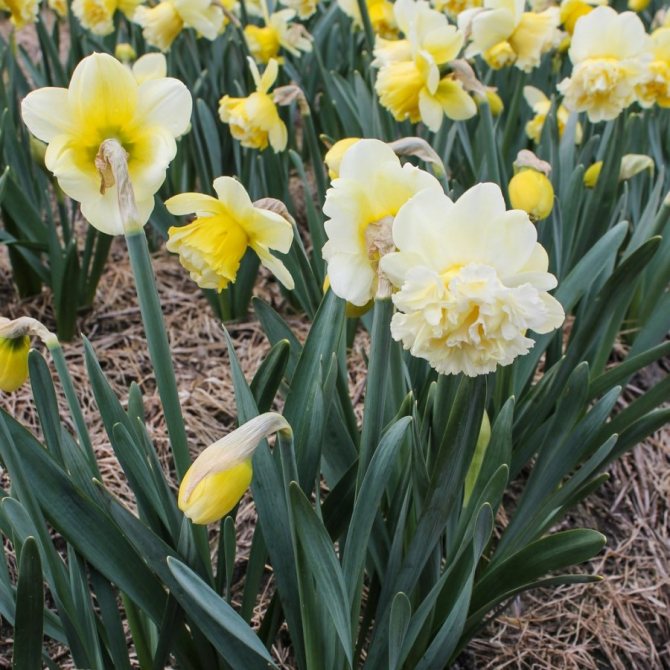

The bulbs should be dug out after the foliage of the plant begins to dry out. The bulbs removed from the ground must be cleaned of soil and spread out in partial shade to dry. After about 10-14 days, you can remove the remnants of leaves from them, inspect and discard low-quality bulbs.
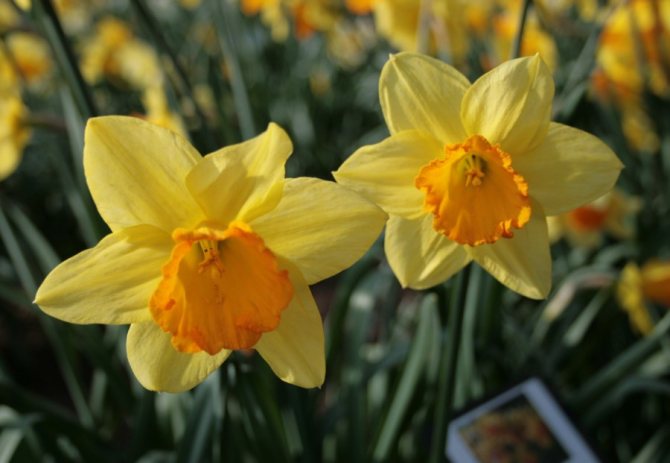

At this stage, many babies themselves fall off the mother's bulb. The roots cannot be separated. Then the bulbs are still dried and then stored in a dry, dark place until planting.
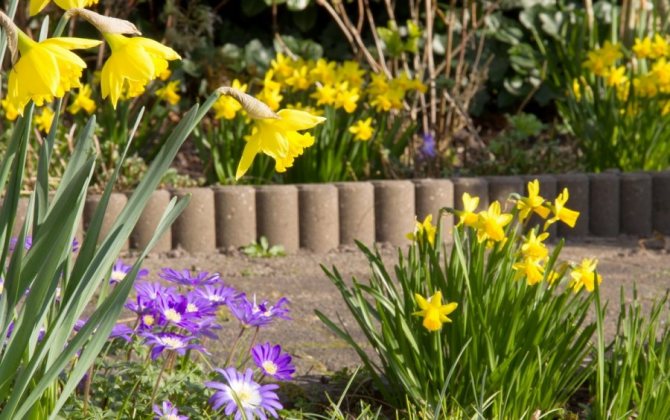

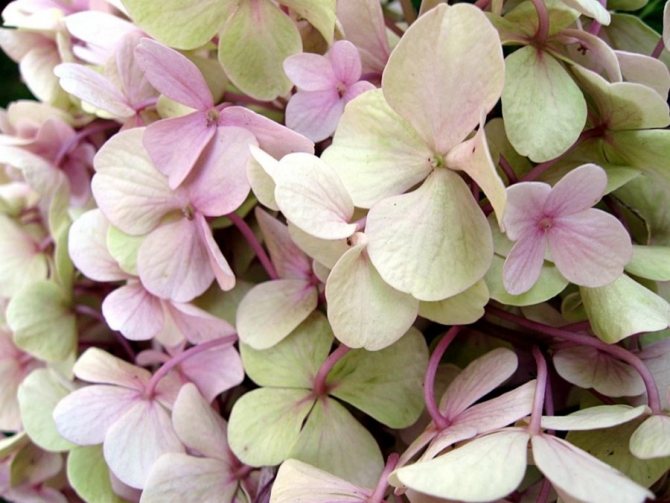

Selection of bulbs for growing
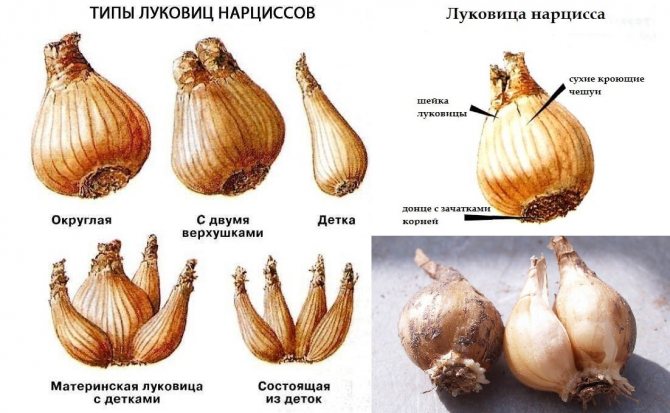

In order for the plant to quickly and easily adapt to indoor conditions, it is necessary to select large, hard bulbs for planting. They should be free from defects: dark spots, scratches, holes, rot. It is better to plant the purchased flower bulbs for indoor cultivation immediately in pots. If the bulbs need to be stored somewhere before planting, then for this they choose a ventilated room where it is dry and warm, since in a damp and cool place the bulbs can take root ahead of time or be attacked by a fungus.
Narcissus in the house
Many people know about planting daffodils in open ground, but not everyone is aware that a delicate flower can be easily grown on the windowsill in their apartment.
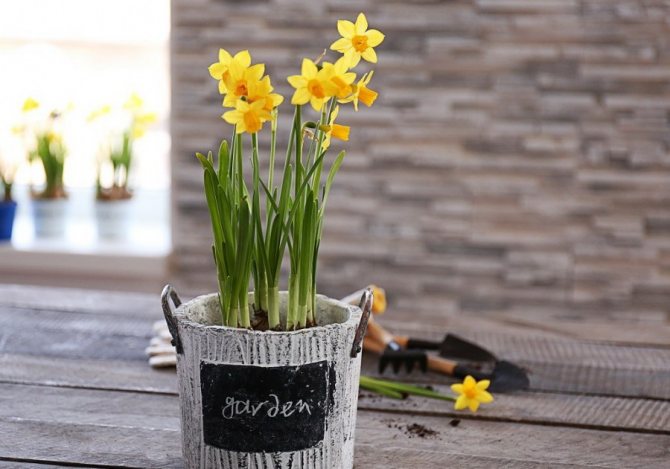

To do this, in the fall, you should prepare small containers with nutrient soil for flowering plants. Make a hole, plant the selected onion, water and transfer the pot to a cool place. Once every 2 weeks, the soil in the pot must be slightly moistened.
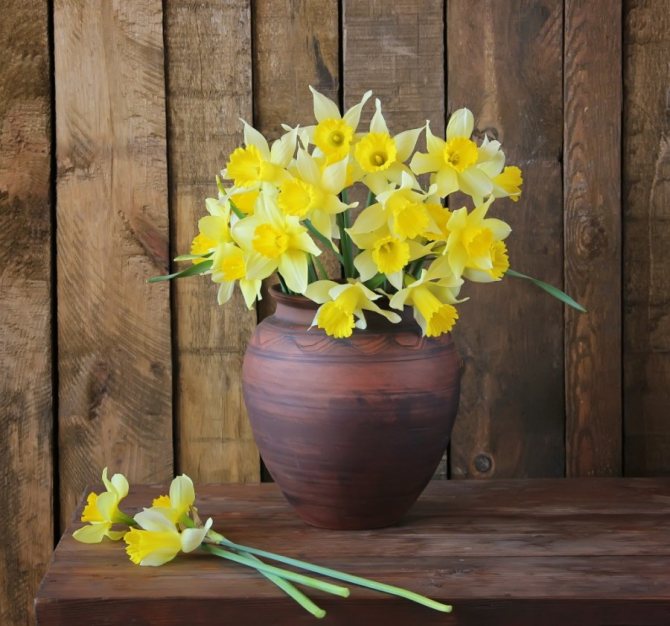

At the end of March, the onion already begins to sprout. From this moment it is recommended to move it to a warm and sunny place. After the bud appears, the temperature in the room should be reduced again.
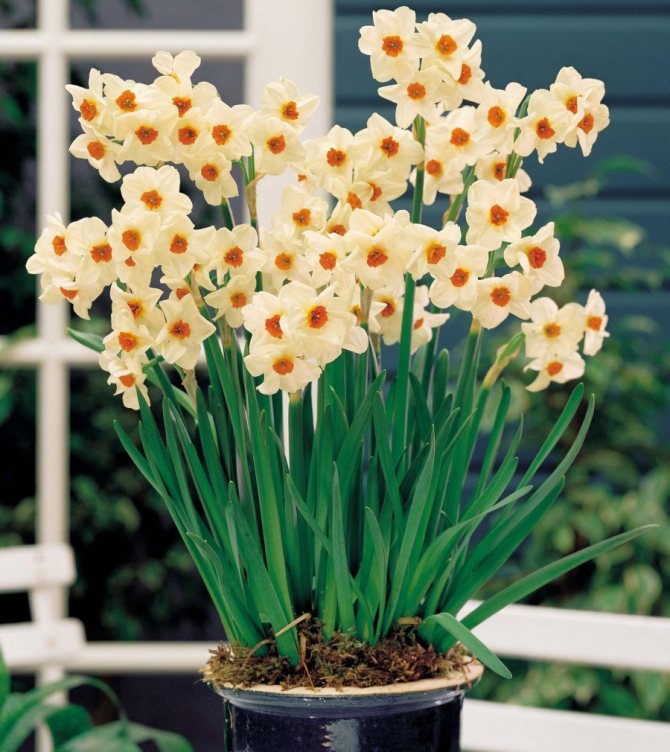

The home flower daffodil does not like drafts. During the period of budding and flowering, it should be fed with a mineral mixture of fertilizers.
Daffodils always look graceful and attractive. Any plant variety is a small masterpiece of nature. With their flowering and beauty, it is they who welcome spring and the approach of warm days.
20
Features of caring for a daffodil at home
Growing daffodils in pots is easy. It is enough to adhere to a few basic rules, and you can grow daffodils by March 8, which will pleasantly surprise your family and guests. One of the first secrets to growing daffodils on a windowsill is to avoid placing them next to other types of flowers.The plant contains some toxic substances that can harm picky plants with a weak root system.
Did you know? In order for the daffodils to bloom by March 8, planting is carried out in the middle or end of November (this depends on the variety). Then the pots are placed in a dark, cool (+8 to +3 degrees), well-ventilated place. Two weeks before the desired flowering period, the pots are transferred to the room and placed on a light windowsill.
Description and pedigree of Zephyranthes
A simple-looking, but very gentle daffodil is considered to be the homeland of Central and South America.
Zephyranthes is a houseplant, perennial bulbous plant belonging to the Amaryllis family.
In Greek it sounds like "Zephyr" in translation Zephyr, which means the name of the Greek God. This name means the warm western breeze "anthes", which in turn means "flower".
Zephyranthes is a "water lily". Amateur flower growers call him an upstart.
Zephyranthes bloom traditionally begins in April and lasts until July. At this time, the beginning of the rainy season in his homeland.
At this time, its peduncles are growing rapidly, completely imperceptibly.
A zephyranthes flower at the very tip blooms in shape like a six-pointed star and the color depends on the variety.
In the open form, the flower lives for only about 2 days after which it withers, then a new flower blooms.
Thus, its continuous flowering cycle allows you to enjoy its beauty.
The flower bulb is ovoid in appearance and usually its diameter reaches 3 cm in diameter; specimens of a larger size are also found, but less often.
If we talk about reproduction, then it should be said that Zephyranthes reproduces easily.
One "mommy" can give up to 15 children. Alternatively, you can, of course, wait for the seeds, planting them and wait for the bulbs, but this is quite a long time and for this reason this method is used very rarely. If, despite the length of the method, you still decide to breed with seeds, then you should know that planting seeds of zephyranthes should begin immediately after harvesting. after even a short time, the seeds lose their quality.
Photo gallery
White daffodil
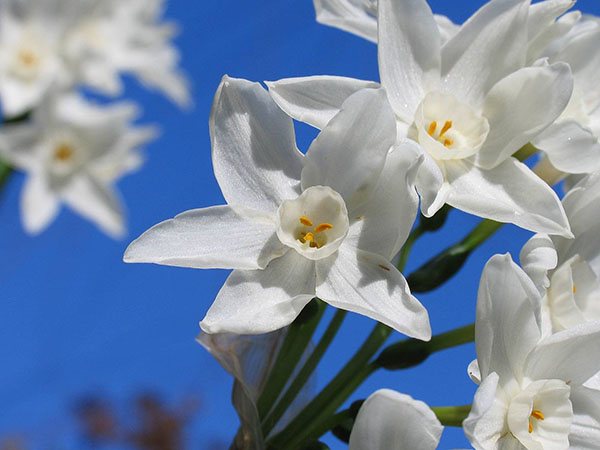

The flower was brought from the Iberian Islands. It grows well on mountain slopes enriched with picturesque vegetation, including abundant grass. White daffodil can be seen in acidified soil or pine forests. An adult flower reaches 35 centimeters. Propagated and planted with bulbs. They are no more than 4 cm in size and are spherical. The flower has thin, multiple green leaves. The flower-bearing stalk does not exceed 23 centimeters. The flower is white, like the inner crown.
White daffodil has been introduced into culture since 1579. It begins to grow actively in mid-spring. By the end of May, the flower dissolves flowers, which are fragrant for no more than 10 days.
When grown in low temperatures, daffodils should be covered during the cold season.
Precocious
A tall variety of large-crowned daffodils with a massive bud with a large perianth. A distinctive feature of these daffodils is an openwork pinkish crown. The edges are of a darker shade, very strongly corrugated. The plant blooms in May and is great for landscaping the garden, as well as decorating the house with cut bouquets.
| Appointment | Group | Stem height | Bloom |
| Large-crowned | 40-45 cm | Mid may | |
Types of Zephyranthes
Among the white-flowered species are known Zephyranthes atamasca, which blooms in March-April in cool rooms, and white, snow-white Zephyranthes candida, which blooms in July-October and also does not like heat. Golden Zephyranthes (Zephyranthes aurea), blooming in December-January, looks amazing. The large-flowered Zephyranthes (Zephyranthes grandiflora) is incredibly beautiful with its large pink flowers with bright orange stamens, blooming in April-May.And in Zephyranthes versicolor, the flowers are white on the inside, and on the outside they have a reddish-green tint. Blooms in January.
All parts of the plant are poisonous, however, it is used in folk medicine for warming compresses for abscesses, liver diseases, convulsions and hepatitis, as well as in the treatment of colds, diabetes, cancer and tuberculosis.
Daffodils Poeticus
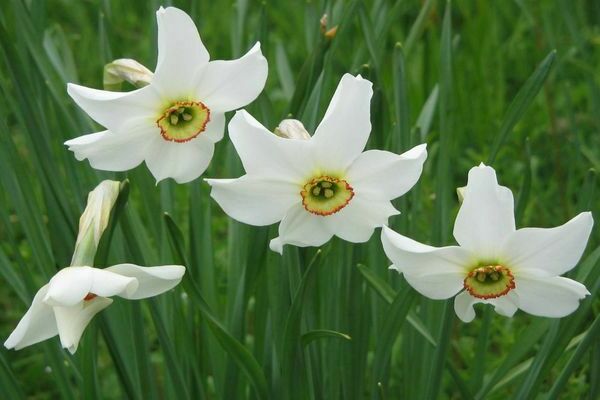

This type of daffodil variety is attractive due to its pronounced aroma. They have flowers arranged one at a time. They are lowered down. Width up to 6 centimeters. Perianth lobes are usually white or creamy. The crown is non-volumetric. Yellowish color with a scarlet border. The peduncle grows upwards by 30 - 45 centimeters.
Favorite varieties:
- "Akteya" (snow-white with a green and yellow crown. And also with orange and red borders throughout the area).
- Milan (snow-white with a yellow crown).
- "Red Rome" (snow-white with a yellowish crown. And also a large scarlet border on it).
Zephyranthes transplant
There are many opinions regarding Zephyranthes transplant. Someone is an adherent of transplanting once a year in spring or autumn, someone advises to refrain from transplanting until the time comes for transplanting into a pot, and someone is sure that the flower should be dug out in spring for planting.
The preferred option may be no annual excavation with transplants. It is enough just to keep an eye on so that the bulbs are not too crowded in the pot. When there are more of them, it just looks amazing, and when flowering, there are not enough words at all to convey its beauty.
In the case when a lot of bulbs were born, then you can simply separate them during transplantation.
And do not forget at the time of transplanting zephyranthes, there may be long necks in the bulbs. In this case, you need to plant so that the neck looks out of the ground. And in the case when the neck is short, then it should be buried completely.
Which pots are best for him
And a little about the pots. For zephyranthes, low bowls are best suited and at the same time wide, depending on the number of bulbs that you are going to plant. And without fail, a decent layer of drainage should be put on the bottom of the pot. And it is clear that after transplanting the flower is not watered for several days.
Zephyranthes bait
Feeding zephyranthes can be done with any fertilizer for bulbous plants once every two weeks.
You can often find recommendations to use Agricola for feeding.
This is how you need to care for zephyranthes at home, since you have decided to have this flower.
Daffodil bouquets
Tall glass and crystal vases are suitable for placing bouquets of these spring flowers on tall stems, and small low vases for dwarf varieties. From low white daffodils, you can create original floristic compositions on a sponge, placing them on a saucer surrounded by pink primroses.
In a vase made of dark-colored ceramics, yellow daffodils surrounded by willow twigs will look beautiful. Flowers of a creamy shade are harmoniously combined with fern leaves. Compositions of several daffodils surrounded by emerald branches of asparagus will look beautiful. In flower baskets, these flowers go well with hyacinths and crocuses. In wedding bouquets, they look beautiful with roses and orchids.
The most striking and daring will be the combination of yellow daffodils in bouquets with colorful blue irises. The same combination will look less catchy when you add other flowers (for example, gerberas) and green twigs to the composition (with them, the bouquet will acquire a special airiness).
The most ideal spring bouquet is the composition of tulips and daffodils, which perfectly complement each other. By harmoniously combining the color scheme of these flowers, you can get original delicate bouquets.Also, such compositions can be supplemented with sprigs of mimosa.
It is important to consider that you cannot add daffodils to a bouquet with other flowers immediately after they are cut. First, they need to be allowed to stand separately in water so that they release the juice, which causes the premature death of other plants of the floristic composition.
Daffodils look beautiful with many other plants, but because of their capriciousness in compatibility, mono-bouquets are the most popular. At the same time, the variety of varieties allows you to make compositions of amazing beauty.
Daffodils Double
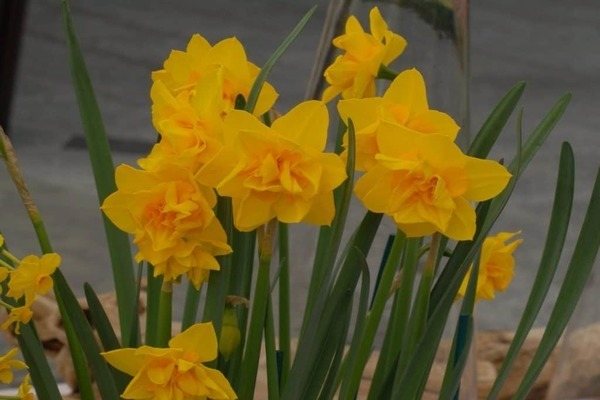

This type of daffodil variety differs from all known plants. One or a couple of flowers are placed on the peduncle. As a rule, with a double perianth or crown. Sometimes both are found. These flowers look amazing.
Terry plants are possible one-color. And also two-colored. As a rule, varieties of snow-white or yellowish color are very popular. And also snow-white with a scarlet crown.
But there are some downsides to these stunning colors. When exposed to water (after heavy rainfall or heavy watering), the flowers sink. And also often break.
Favorite varieties:
- "Akropolis" (snow-white with a scarlet residual crown).
- Outer Space (snow-white with a double pinkish crown).
- Chirfulness (white).
- "Flower Drift" (pure white with an orange crown).
- Golden Ducat (bright yellow).
- "Tahiti" (yellowish with a scarlet crown).
- "Texas" (yellowish with an orange tint).
Thalia (Waist)
An early variety of tubular daffodils, which can delight with flowers as early as March. Flowering is intense and quite long for daffodils. Small white flowers contrast harmoniously with dark green narrow foliage. Due to its low height and neat shape, the variety is suitable for planting in the foreground of a flower garden or alpine slide, as well as for home distillation.
| Appointment | Group | Stem height | Bloom |
| Triandrus | 30-40 cm | End of March - beginning of April | |
Daffodils have long adapted to the changeable climate of the middle zone, therefore they are considered quite traditional plants for a classic garden. However, if you competently approach the choice of varieties, you can grow such specimens that will surprise even the most sophisticated flower growers with their beauty.
Not everyone knows, but there are many varieties of daffodils. Plants differ in the type of flower, the method of growing, the period and duration of flowering. Consider the most popular and most beautiful varieties of daffodils, their photos and the correct name.
We present to your attention a catalog of daffodil varieties with photos and names
Daffodils tubular: varieties with photos and names
Large-crowned daffodils: varieties with photos and names
Small-crowned daffodils: varieties with photos and names
Botanical daffodils: varieties with photos and names
Daffodils Triandras
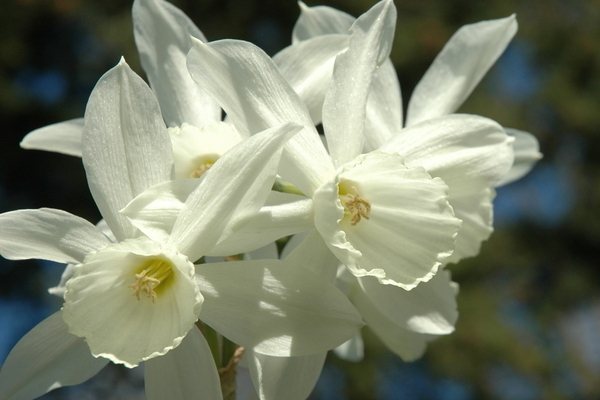

On a small peduncle, as a rule, about 25 centimeters, two or more dropping flowers open. In this case, the perianth lobes are slightly tilted back. The color of plants, as a rule, is snow-white, yellowish. And also gold.
Favorite varieties:
- Ice Wings (white with a large crown).
- "Thalia" (snow-white).
- "Tresembl" (yellowish).
- Javera (yellowish).
How to choose planting material
The average cost of packing seeds is 84 rubles. Garden nurseries sell Delnasho daffodil bulbs at a price of 34.30 rubles per piece.
It is not recommended to purchase planting material in the spring.
Before buying, you need to find out the harvest date, storage conditions for planting material, inspect the condition of the bulbs. It is not recommended to purchase tubers in early spring. Bulbs with a sprout are a sign of poor-quality planting material.
When to prune daffodils?
Whether or not daffodils should be pruned is a moot point.After the plant has bloomed, some gardeners cut the peduncles and leaves. Others do not subject the bushes to such stress and wait until they dry out so that all useful components for the culture can concentrate in the bulbs. Then they simply remove the bulbs from the ground, if required, or remove dry foliage (it is easy to cut). It is a matter of practice to say for sure which option is correct. After the gardener has tried both options, he will be able to choose the best one for himself.
Difficulties in leaving
With excessive dampness and excessive watering, Zephyranthes is prone to root rot. One of the signs of bulb rotting is that the leaves turn yellow and dry. In this case, you need to renew the land, remove the infected parts of the plant and carry out the fungicide treatment.
Parasites appear on zephyranthes extremely rarely. Only occasionally can you find scale insects, spider mites or whiteflies. Insecticide treatment will get rid of pests much faster than folk remedies.
Sometimes flower growers are faced with the fact that zephyranthes does not bloom. The reason may lie in the wrong selection of the pot. If it is too large and deep, the plant will actively increase the root mass, and there will be no strength left for flowering.
Zephyranthes flower
Zephyranthes - perennial small-bulbous plant of the amaryllis family. In nature, there are about 40 species of zephyranthes. The bulb is rounded, up to 3 cm in diameter, with a short or elongated neck. The bulb should be completely buried in the soil. Leaves are narrow, belt-like or linear, dark green, 30-40cm long and 1cm wide. Tubular peduncle up to 30 cm high, flowers are single, wide open, up to 8 cm in diameter, similar to crocuses, appear simultaneously with leaves. Zephyranthes blooms in spring, summer and winter with white, red, pink flowers. There are bicolor species.
Poetic daffodil
The natural habitat of this variety is mountainous areas with water sources such as lakes and rivers. First bred in 1538 near the Mediterranean Sea. The plant is characterized by accelerated growth and abundant flowering. Adequate humidity and direct sunlight on the leaves are important.
In adulthood, the daffodil can reach half a meter in height. Reproduction takes place using spherical or ovoid bulbs. About five long and flat sheets of deep green color grow from one bush. The inflorescences bloom one at a time, the color is white, the heads are directed towards the ground.
The flower was brought from the mountainous regions. In nature, the poetic daffodil lives on hills, near water bodies and springs. The species was originally bred near the Mediterranean Sea and not far from Italy. The plant grows rapidly and blooms among chestnut trees. For full development, the flower needs moderate moisture and direct sunlight.
The flower grows up to 50 centimeters in height. Propagated by bulbs that are in the shape of a ball or chicken egg, with a pointed end. One bush of the poetic daffodil produces up to five flat, long leaves. They are bright green in color. Flowers bloom on a single branch, white, heads look down. Inside they have a crown of bright yellow color.
The species was first bred in 1538. The Italians liked the daffodil for its strong fragrance. The size of the blossoming flower reaches six centimeters. The flower-bearing stalk grows longer than the leaves and can reach fifty centimeters. The plant emerges from the ground in early spring, is actively growing and begins to bloom in the month of May. Flowering period up to 12 days.
After reviewing the photo with the daffodil and the description of the variety, you can choose the plant you like of the poetic daffodil and breed it on your site.
Diseases and pests
Like other plants and flowers, daffodils are susceptible to various diseases, and also often become an object for feeding some pests.
- Fusarium okusporum f. narcissi causes the severe disease of fusarium in daffodils;
- Sclerotinia narcissicola attacks daffodils with sclerocial rot.
Daffodils are susceptible to viral diseases and attack by the following pests:
- root, bulbous and stem nematodes;
- daffodil and bulb flies;
- thrips.
Yellow daffodil
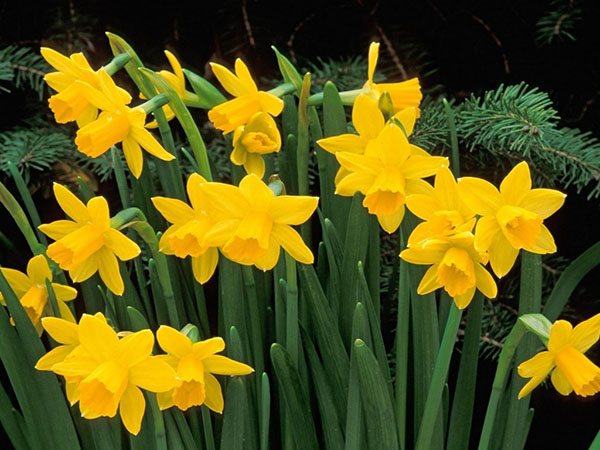

The representative of this variety has a second name - false daffodil. The flower was brought from France, Germany and southern Italy. Grows well on the slopes of the Caucasus Mountains. The yellow daffodil grows short. An adult plant reaches 30 centimeters. Propagated by bulbs, the diameter of which does not exceed 5 centimeters. They are round, less often oval. One flower blooms on a flower stem, which reaches a diameter of 4 cm. The flower, in the process of active growth, releases thin, dark green leaves, which are located 10 centimeters below the flower.
Inside the blossoming flower there is a crown, bright yellow in color with a corrugated uneven edge. The flowering period of the yellow daffodil begins in mid-May. It lasts no more than 15 days. The flower has been bred and introduced into garden culture since 1500.
Thanks to this variety, many forms of the plant have been bred by crossing.
Gardeners use yellow daffodil for ennobling near house plots and rocky gardens, planting them next to tulips, a royal crown, in mixed plantings and compositions with juniper.
Rosy Cloud (Rosy Cloud)
The Rosy Cloud variety of double daffodils of white-pink color is considered the most unique of all existing ones, since it combines color and doubleness that are atypical for these plants. The openwork crown of flowers of this variety is corrugated much stronger than that of all other varieties. In addition, the color of the flowers can change (its saturation depends on the weather conditions). These daffodils look great anywhere in the garden and are also great for cutting.
| Appointment | Group | Stem height | Bloom |
| Terry | 30-50 cm | End of April - beginning of May | |
Description of the plant
Zephyranthes is a flowering bulbous plant that covers the tropical rainforests of Central and South America with a fragrant carpet. Flowers bloom during the rainy season, when the Zephyr wind begins to blow. Therefore, the name of the plant can be translated as "Zephyr flower". It is also called the room lily, "upstart" or home daffodil.
The root system of zephyranthes is a small oblong or rounded bulbs up to 3.5 cm long. A small basal neck rises above the ground, from which a few leaf rosettes grow. Narrow belt-like leaves of bright green color can reach a length of 20-35 cm.The width of smooth glossy leaves is only 0.5-3 mm.
Flowering begins in April and can last all summer. From the center of the leaf rosette, a long peduncle with a single flower grows rather quickly. The shape of the bud resembles a crocus. Six lanceolate petals with a pointed edge are wide open to the sides, the core is decorated with short bright yellow anthers. Flowers can be white, yellow or pink in color. The flower diameter is 4-8 cm. Each bud lasts only 1-3 days.
Crackington
A variety of double daffodils with very bright and catchy flowers. Crackington daffodils have a rich yellow color with an equally striking orange center. Of all the varieties of the terry group, this variety is considered one of the earliest (blooms in April). Flowers with strong peduncles, which allows them to be grown in any corner of the garden. The plant gives an excellent cut.
| Appointment | Group | Stem height | Bloom |
| Terry | 45-60 cm | Early April - mid april | |
Why don't daffodils bloom?
The main reason for the lack of flowers in daffodils is the long development in the same place.If the bulb has not been transplanted for a long time, it is most likely overgrown with children, it is quite difficult for her to draw strength from the earth for herself, therefore there is no flowering. In this case, you just need to dig up the bulbs, divide and plant again.
It is also possible that the culture lacks nutrition. The soil should be fertilized and well moistened. Often, pests and diseases are the reason for the lack of flowers. If the bulbs are sick, then they need to be treated with fungicides or insecticides, then, after recovery, they will grow again and give flowers. However, in some cases, treatment does not help. If the onion is severely affected, it should be thrown away, but it is better to burn it.
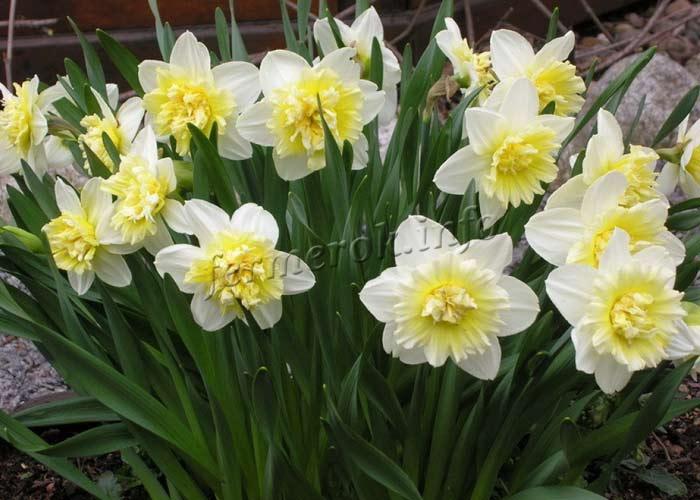

Photo Terry Narcissus
Pink Champagne
The variety belongs to the group of double daffodils with crown flowers. In one flower, you can observe a mixture of white and bright pink shades. The multicolored petals are randomly arranged, which gives Pink Champagne a special elegance. These daffodils bloom in early May, suitable for growing in a flower garden or along a path.
| Appointment | Group | Stem height | Bloom |
| Terry | 35-40 cm | Early may | |
Mount Hood
This variety of tubular daffodils blooms in April-May. The flowers are snow-white, very large - up to 13 cm, they are held on strong peduncles. The color of one bud can vary from creamy white to ivory. The color intensity of daffodils depends on weather conditions: the warmer the spring, the richer the color will be.
The variety is especially appreciated for its delicate color and light aroma. Mount Hood daffodils bloom early and are suitable for planting anywhere in the garden: in a flower bed, on an alpine slide, in a curb, on a rabat, between shrubs. Suitable for cutting.
| Appointment | Group | Stem height | Bloom |
| Tubular | 40-50 cm | End of April - beginning of May | |
Domestic daffodils, disease control
Fungi are the most dangerous for the narcissus. Any waterlogging of the soil, non-observance of the temperature regime and lighting throughout the year lead to their development. Fungi mercilessly destroy the bulb and it is not always possible to save the plant. Fungicides are used as a treatment, but they are effective only at the initial stage of the disease.
Pests rarely affect daffodils. These can be nematodes or bulb flies. Prevention of their appearance consists in the timely removal of withering flowers and leaves, loosening the soil, and preventive treatment with insecticides.
Advice! Proper storage of bulbs helps prevent the development of fungi and pests. They should be kept in the dark and at a temperature not higher than + 10⁰С.
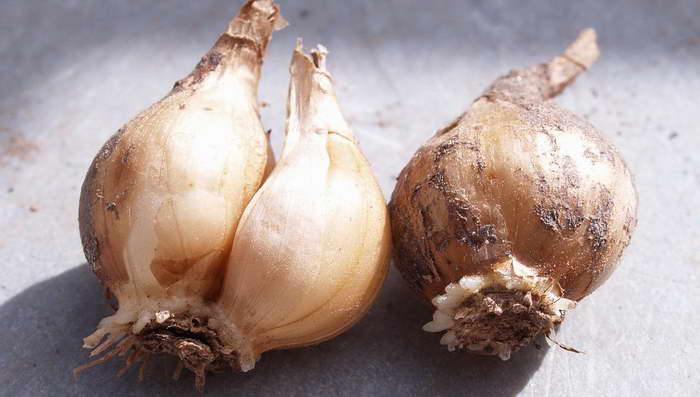

As you can see, forcing daffodils at home is a simple and fun activity that does not require money, a lot of time and effort. Observe the conditions for growing flowers at all stages of development, and daffodils will bloom with gratitude and delight the eye.
Comments (2)
Ruzanova
19.05.2018 at 14:27 |
I have a daffodil growing on the windowsill in my kitchen at home, and I will tell you that it practically does not require maintenance. The main thing is to water on time and be sure to feed in the spring. After a while, you can change the land.Reply
Julia Expert Plodogorod
16.10.2019 at 17:08 |
Hello Ruzanova! Although this plant is really quite unpretentious, it is important to initially create the correct conditions for it, otherwise there is a risk that the culture will get sick. So, even at the planting stage, it is important to use loose and drained soil. And also lay a layer of pebbles or sawdust on the bottom of the pot or other container to improve the outflow of moisture.
Also, regardless of whether you prepared the soil mixture yourself or purchased at a flower shop, we recommend roasting the soil in the oven or pouring boiling water over it.
Another problem that can negatively affect the development of indoor narcissists is spider mites. In an apartment, the air is often rather dry, especially during the heating season.For this reason, it is important to keep flowers away from radiators and batteries.
Although on winter days spraying directly on the crown of the flower is undesirable, it can provoke decay, it is worth taking care of the humidity of the air. For example, place a container with water on the windowsill or use a stationary air humidifier.
Also, as a preventive measure for the multiplication of mites, we recommend treating the bulbs before planting in order to exclude infection through poor-quality planting material and use Milady's soil tablets. They are at the same time protection from a number of pests, and also nourish the flower with useful substances.
If, despite all the measures, pests still appear, you need to start by bathing the plant. It is important that water does not flow into the pot during the process. Then you can use a solution of soap and ash. If this measure did not help, you need to move on to chemicals, for example, the drug Neoron. It is important to carry out several treatments.
Reply
Daffodils are real animators of spring interiors
When the windows of flower shops literally gush with bright colors of spring crocuses, snowdrops, hyacinths and daffodils, it means that spring is slowly creeping in. One of the first to appear are the first sprouts of daffodils, which give us a unique feeling of spring freshness and vitality. With the blossoming of "Indoor plant February 2016", this is the honorary name that the Flower Bureau of Holland awarded the pot daffodil, nature wakes up from a long winter sleep, and the house is filled with sunlight, light refined aroma and fresh air.
The first rays of the spring sun make the sprouts of daffodils rise from the ground, and then bloom with their simple and double flowers, which are holly and crown, tubular and cyclamen-like and are represented by all sorts of variations of the yellow-white color scheme. Today, 88 different species of this bulbous perennial are known, derived from various wild species of daffodils, which are native to the northern hemisphere. Daffodils, which with their beauty bring the first colors of spring after a long winter, came to us from southern Europe, in particular, from Spain and Portugal. Some of them impress not only with their exquisite appearance, but also with a pleasant fragrance that creates a spring mood in the house.
Large selection of varieties
There are many varieties of daffodil that can be grown at home. From December to March inclusive, they decorate our interiors with mainly yellow and white flowers, located on separate peduncles. But, thanks to the unquenchable passion of flower growers for new varieties, breeders have bred new daffodils, which have replenished the color range with splashes of salmon and pink. Depending on the shape and structure of the flower, daffodils are classified into the following groups:
- Tubular - varieties of this group are characterized by the presence of one flower on a strong peduncle, the tube is longer than flower petals.
- Terry - the flowers of this group of bulbous plants are perianth petals collected in curly ruffles.
- Large-crowned - a feature of the flowers of this group is the crown, which is more than 1/3 of the length of the perianth lobes.
- Small-crowned - crown no more than 1/3 of the length of the perianth lobes.
- Cyclamen-shaped - the petals are strongly bent back, the tube is narrow and long. The flower is planted at an acute angle to the stem on a short stem.
- Triandusaceae - on the peduncle there are 2 - 6 drooping flowers with lobes bent upwards and a large tube.
- Tacetate - 3-8 small flowers on the peduncle, exuding an intense aroma.
- Poetic - characterized by single fragrant flowers with a short crown.
- Jonquilla - varieties of this group were obtained by crossing with the specific daffodil Jonquilla (N. jonquilla). Small flowers with small crowns.
- Split-crown - this group combines varieties with a strong dissection of the crown.
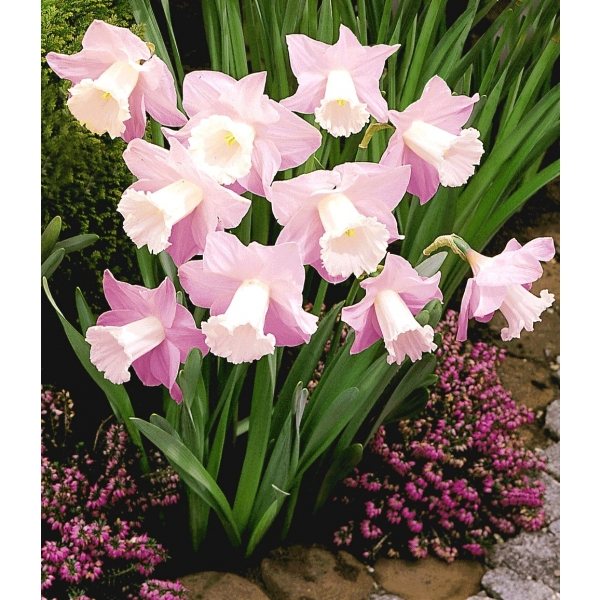

Unusual pink daffodils 'Rosa Trompete'
What to look for when buying potted daffodils?
When buying potted daffodils, you need to pay attention to the size of the pot, the number of bulbs in one pot or vase, and the color and maturity of the buds. Of course, it is very important that the plant looks healthy. Before buying, carefully inspect the daffodils for pests, check if the bulbs are sufficiently entrenched in the ground. If the bulbs are loose, then they are poorly rooted. Avoid choosing plants with dry buds and leaf tips that are the result of improper care. Examine the surface of the substrate and bulbs - they should not have a white layer of mold, which forms from excessive watering or from excessively high humidity. Pay attention to plants with well-developed buds, in which the color of future flowers is already visible - in such specimens, the risk of bud drying is minimal.
Caring for indoor daffodils
Despite the fact that blooming daffodils in pots are increasingly sold in winter, they can be called indoor plants only conditionally, since home conditions are not entirely suitable for growing spring flowers - it is too warm. But if you reproduce the natural growing conditions for daffodils, then they will delight us with their beauty for a long time.
To prolong the blooming of flowers in full bloom, you need to transfer the potted daffodils to a bright and cool place, such as a glassed-in balcony. The cooler the room, the longer our spring flowers bloom. A comfortable temperature is considered in the range from + 100C to + 170C. Daffodils always turn their flower heads towards the sun, so turn the pot regularly to avoid twisting the stem.
The soil in the pot should be evenly moist, but not wet. The frequency of watering depends on the temperature of the content. The cooler it is in the room, the less often you need to water. In addition, watering has a direct effect on the size of the daffodils - the more water the plant receives, the faster it grows. The narcissus reacts quite normally to drying out of the soil between waterings, however, he does not tolerate complete drying out or the bay of an earthen coma.
Freshly purchased or transplanted daffodils should not be fertilized for the first 6 to 8 weeks. In other cases, during the period of active growth, that is, the formation of leaves or flowers, it is recommended to add fertilizers for flowering plants to the water for irrigation once a month. The fertilizer dose should be half as much as indicated in the instructions.
At the end of flowering, caring for the daffodils remains the same until the leaves turn yellow and dry. Do not prune green leaves under any circumstances. During the period of natural death, the necessary nutrients are transferred from the leaves to the bulb. After the leaves turn yellow, you should stop feeding and reduce watering. At this time, daughter bulbs are formed, therefore, it is impossible to completely abandon watering. If you cannot plant the bulbs in the garden after flowering, let them spend the summer in a pot. If this happens, move the pots of bulbs to a dark place, such as a basement, and stop watering completely.
At the end of September / beginning of October, we take our bulbs in pots from our summer apartment and transplant them into fresh, loose soil. To lay flower buds next year, the bulbs should be sent for stratification, that is, for preliminary aging at low temperatures. To do this, you can put the pot of bulbs in the vegetable section of the refrigerator. During this period, the soil in the peas is kept slightly moist. After eight weeks, the daffodils are relocated and treated as described above.
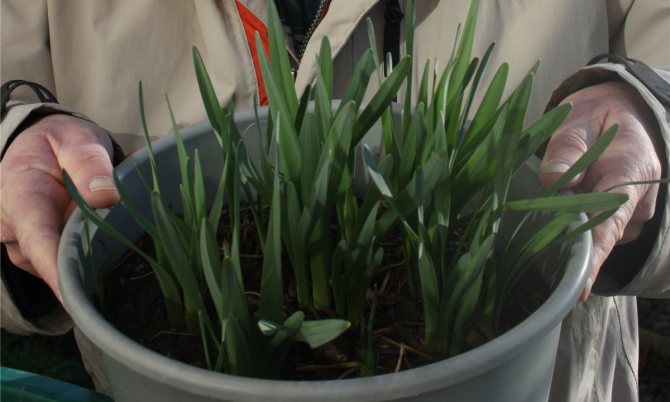

Daffodils in the interior
Changed space
Daffodils, with their clear structure and bright colors, add gentle spring accents to the atmosphere of the home. These bulbous perennials in pots look especially beautiful, creating a strong contrast to the natural color of the plant, for example, white daffodils in a black pots with a checkered pattern.
Snow-white or sunny-yellow daffodils dilute the black-and-white range and the severity of the lines of the interior design fashionable this season called "Changed Space", giving it a festive look.
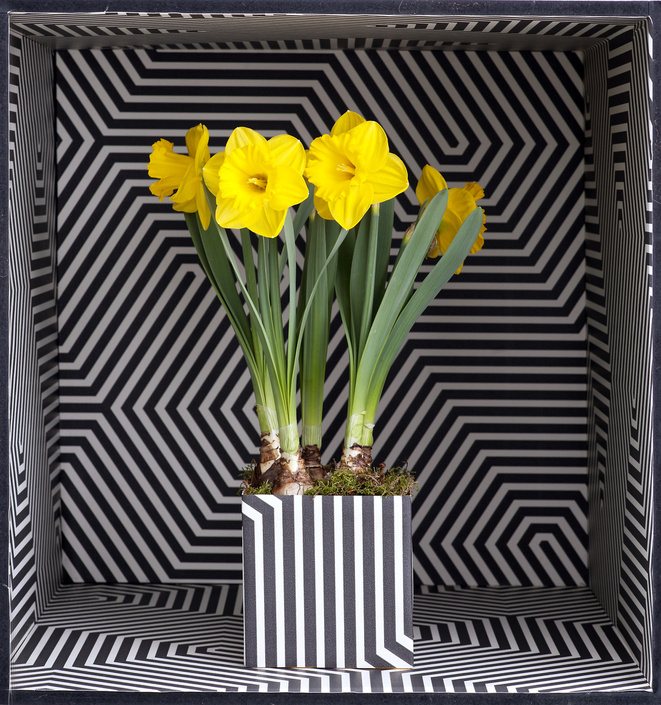

These spring flowers in small pots, grouped on the shelf of an unremarkable metal cabinet, turn it into a decorative object and at the same time add variety to the interior of the room.
Cheerful confusion
Outwardly, daffodils look just as great as their incomparable scent, which reminds us of spring. By combining several specimens of plants in monochrome white or yellow colors, a unique floral trend is created that emphasizes the Art Nouveau style. To immerse yourself in a modern style in more detail, you can place a daffodil masterpiece in a transparent container, as well as in planters made of metal, plastic, leather or polished wood.
The variegated color scheme of daffodil combinations will appeal to the originals. The yellow-white-pink mix gives the interior a perky and cheerful look.
Hanging basket full of spring primroses
Brightly sunny daffodils in the last cloudy days of winter will bring into the house the energy of warmth, joy and fun, will help to cope with seasonal depression. With an original hand-made hanging basket filled with houseplants in February 2019, the anticipation of spring will become even brighter and more desirable. As if by magic, the bike basket transforms into a colorful hanging potted daffodil design that will brilliantly decorate your front door, welcoming everyone who enters the house.
To create a daffodil basket, you will need the following materials:
- Metal basket
- Daffodils in pots
- A piece of pond film, canvas, or sturdy trash bag
- Black braided cord for hanging the basket
- Pieces of black cloth and an unnecessary red T-shirt
- But also scissors
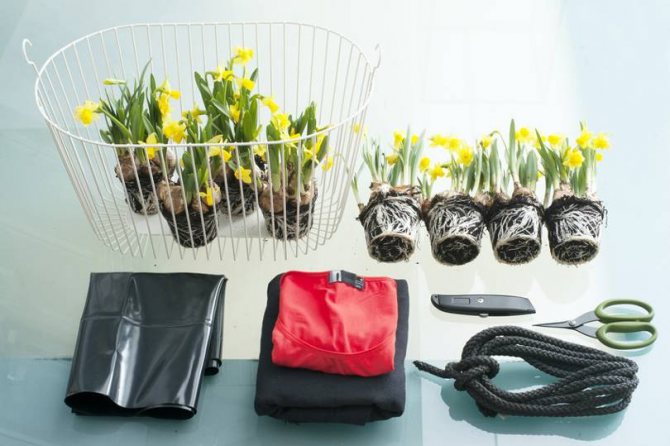

Step-by-step process for making a daffodil basket:
Step one:
Braid the bottom of the basket with cut strips of black fabric to such a height that the daffodil bulbs are clearly visible from all sides. Braid the top of the basket with strips cut from a red T-shirt.
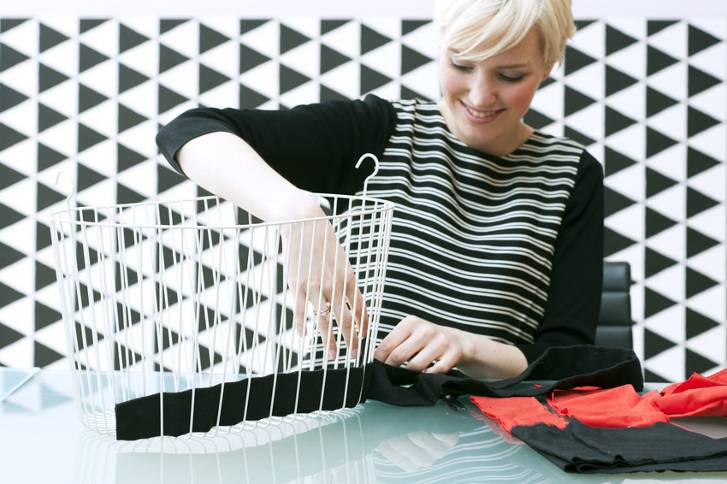

Step two:
Line the bottom of the basket with a sealing film, making low sides.
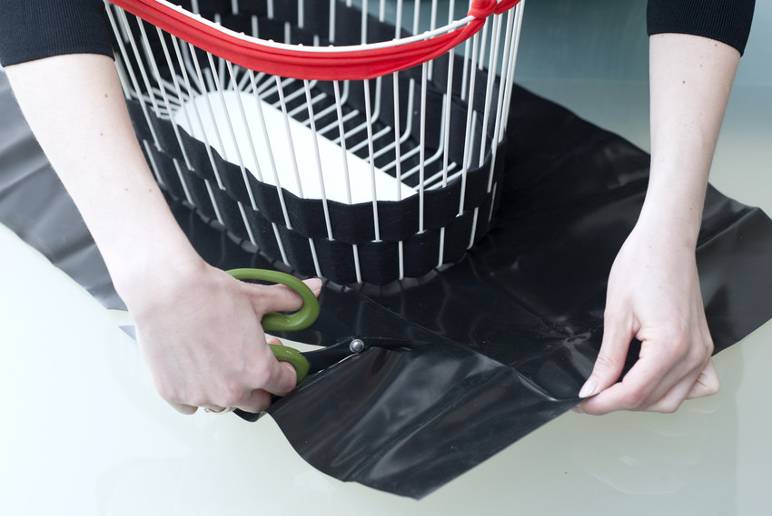

Step three:
Next, remove the daffodils from the plastic pots and place them tightly together in the basket. Then attach a black rope to the basket and hang it where you can see it, such as a standing hanger in the hallway.
Translation: Lesya V. specially for the Internet portal of the garden
Daffodils Cyclamineus
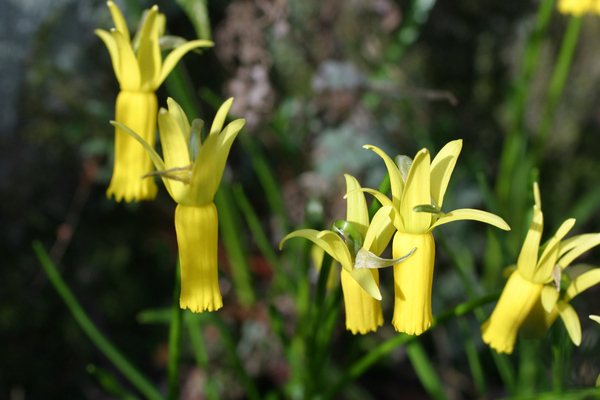

In this plant species, the perianth lobes are powerfully tilted back. Thin and elongated crown. Its size is larger than the size of the perianth lobes. Flowers are usually arranged one at a time. Lowered, 6 - 8 centimeters wide. The plant grows to a height of 15 - 25 centimeters.
Favorite varieties:
- "Jenny" (beige with a soft crown).
- Jetfire "(yellowish with a corrugated orange crown).
- "Kotinga" (snow-white with a pinkish crown).
- "Tete-a-tete" (yellowish with an orange crown).
Taurus
An unusual variety of large-crowned daffodils, which with its flowers at the same time resembles a lily and a carnation. The diameter of the flower is 10-12 cm, the height of the peduncle is up to 50 cm. The tall large crown (lemon-yellow at the base and delicate apricot at the edges) looks spectacular against the background of white petals. The variety is suitable for cutting, as it has tall and strong flower stalks. In the garden, daffodils of this variety look good in group plantings.They can also be planted along the paths.
| Appointment | Group | Stem height | Bloom |
| Large-crowned | 30-50 cm | End of April - beginning of May | |
Pink daffodil
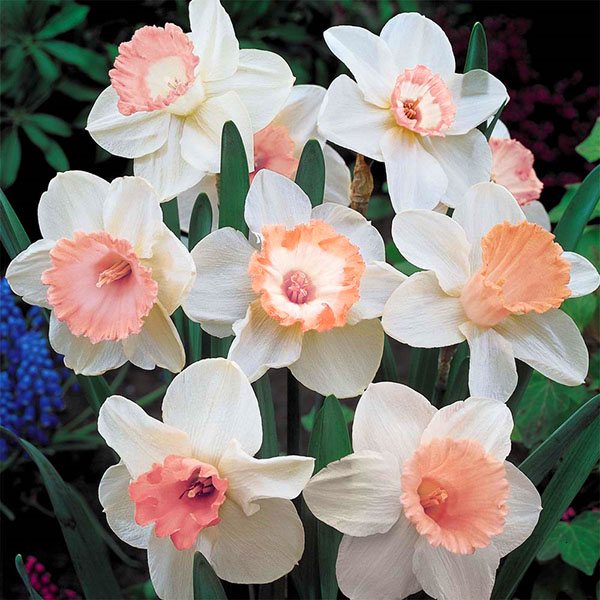

The flower was brought from western Italy in 1520. At about the same time, the variety was introduced to the culture in the south of France. Pink daffodil differs from other plant species in its rather high size. The flower reaches 45 centimeters. The leaves are dark green and wider than that of other species by 0.5 centimeters. Differs in the color of the flower itself. During the flowering period, 1 bud is located on the pedicel. The flower has a white color with a pale pink crown, quite unusual for this group of plants.
Read also How to sprout hot peppers
Pink daffodil propagates with the help of bulbs. In an adult plant, they can reach 5 centimeters. Daffodil blooms in early May. To preserve the flower, it is better to dig up the bulb for a period of rest and keep it in a dark place until the onset of spring. Pink daffodil can not only beautify the garden area, but also surprise guests. The plant will draw attention to the flower bed in any design.

